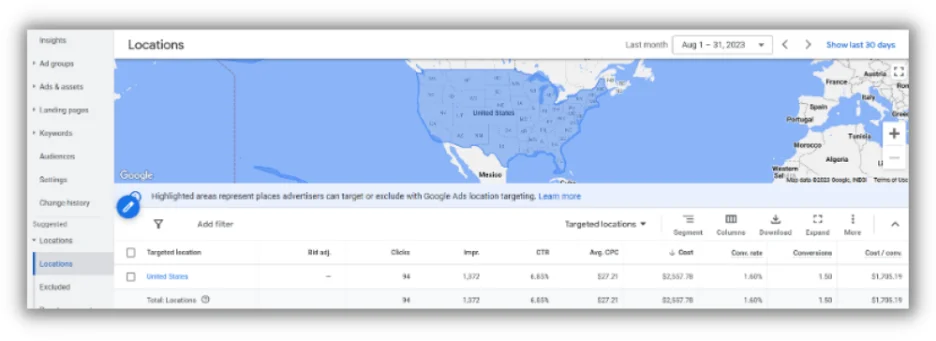PPC
11 Inspiring Vision Statement Examples (+How to Craft Your Own)

Your company sells a product or an offering, but your branding communicates so much more than this. It communicates the value your product provides. The way your offering is different from your competitors’. The personality you display in your content and embody in your company culture.
Your vision statement is a key piece of this branding that helps to communicates all this and more.
Here, we’re going over everything you need to know to get started crafting your company’s vision statement and how to put it to use.
We’ll cover:
Plus, we’ll include some of our favorite vision statement examples to help you get inspired to create your own bigger-picture company impact.
What is a vision statement?
A vision statement outlines your company’s long-term goals. A good vision statement describes the bigger-picture impact of the work you’re doing day-to-day. A great vision statement includes all of this and inspires your employees, your customers, and your community to join you in realizing this vision.
You want to make sure you’re creating a great vision statement—and we’ll break down how to do that.
What’s the difference between a mission vs vision statement?
The difference between your mission statement and your vision statement is important but simple: Your vision is the result of your mission.
Your vision statement fits into a larger part of your brand identity that also includes your mission statement and your company values. Here’s a quick overview:
- Your mission statement defines what you do, who you do it for, how you do it, and why it matters.
- Your vision statement outlines your long-term goals, the impact of achieving this mission.
- Your values are the guiding principles and beliefs that your brand embodies.
Your vision statement then should be the result of your mission statement. By working towards your mission, your company will achieve the long-term, bigger-picture vision for your brand, your customers, and sometimes even society.
This distinction is good to remember, especially considering how often mission and vision statements get confused. When you’re presenting this to your employees and your customers, make sure you’re being as clear as possible.
How to write a vision statement
Now that we’re clear on what a vision statement is and why it’s important, it’s time to get started drafting your own. Here’s how.
1. Think big
You want to draft a great vision statement that describes your company’s long-term goals and the impact of achieving them to inspire your customers, your employees, and your community. That means thinking big during a brainstorm before narrowing your ideas and messages down.
Here are some questions to start with:
- What do you want your business to change for your customers? For the world?
- How does your product or offering help your customers? How would it change the industry if everyone was your customer?
- How does that value you provide your customers change their lives? How does that change society?
- What does the success of your business look like in 10 years? What does that success look like for your customers?
Go through and answer these questions to start identifying the bigger impact of your business. And remember not to edit yourself just yet—giant goals like solving the housing crisis or improving access to healthcare are on the table. This is your vision for the long term, not exactly your promise to deliver right now.
2. Connect to your mission
Even though your vision statement should be future-looking, it should still be logically connected to what your company is working on today. That’s where connecting your mission statement comes in.
Once you have a few big ideas that you want to cover, pair these up with your mission statement. Does achieving your mission accomplish these big ideas?
Let’s consider an example. LinkedIn’s vision is to create economic opportunity for every member of the global workforce. Its mission is to connect the world’s professionals to make them more productive and successful.
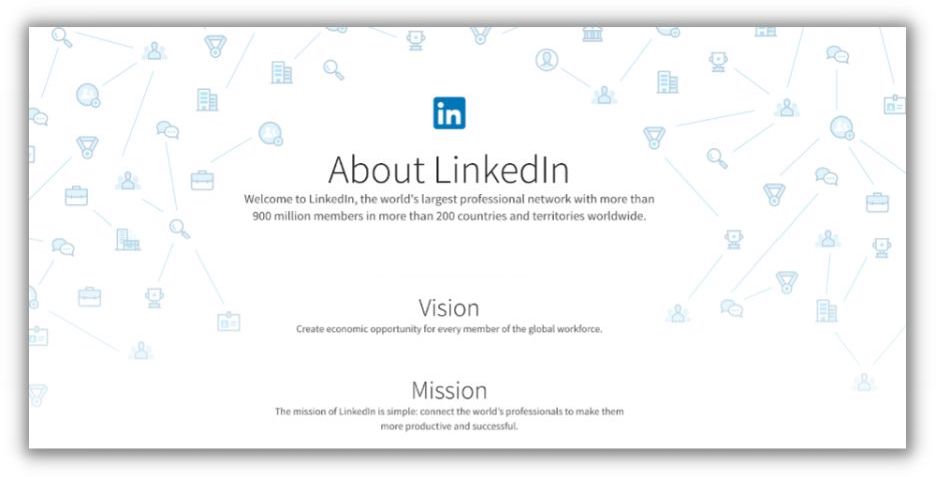
Even though the vision is an expansive and aspirational one, it’s still connected to the mission. If you can connect all professionals and enable productivity and success, then you can create economic opportunities for the workforce globally.
Remember, it shouldn’t be the next step result of your mission, but it should be related.
3. Make sure you’re including emotion
The scope of your vision should be inspiring, but that doesn’t mean you’re off the hook with copywriting. Once you have the ideas down—the long terms goal or goals and the impact of achieving these—it’s time to start fine-tuning.
When you’re determining which words to use in your vision statement, remember you want to evoke an emotional reaction.
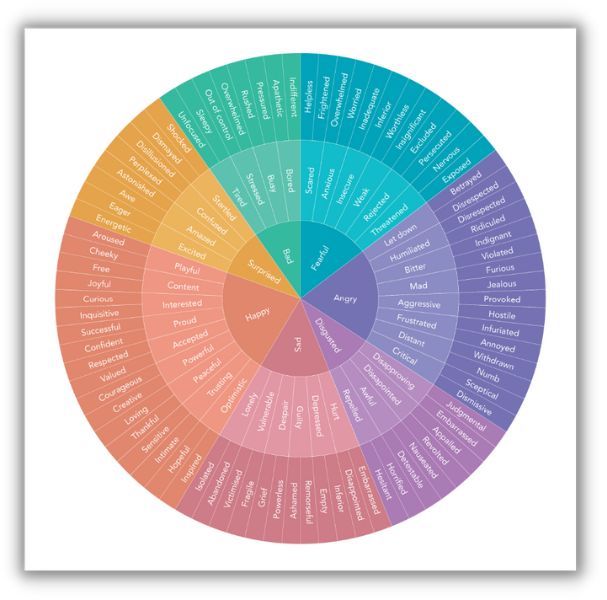
The emotional reaction should be positive, and it should be motivating. Other than this, though, it depends on your brand whether you’re hoping to inspire joy, action, peacefulness, or anything else. Once you determine how you want people to feel in reaction to your vision statement, make sure to choose your words accordingly.
4. Keep it short
Your vision statement should be one or two sentences at most. If it’s helpful to create a longer document that breaks down the vision for your company for your leadership team or board, that’s a worthwhile exercise. But that shouldn’t be the marketing copy that you’re using in your branding.
Keep it short, simple, and straightforward. That’s the best way for everyone to understand, remember, and most importantly connect with your vision.
5. Share it widely
Your vision statement is foundational marketing copy, and you should make the most of it—-for your company culture, your customer marketing, and even your prospective employees.
You should be sure to include your vision statement in your employer branding, whether that’s on your career page or in your company descriptions. In fact, LinkedIn found that a strong corporate brand can reduce cost per hire by more than 50%.
And be sure not to focus only on sharing with people outside of the company. Your employees are working towards your company’s mission each day, but that’s still on the path of your vision. Make sure to communicate that clearly.
11 inspiring vision statement examples
I don’t know about you, but I hate starting from a blank page. There are too many options, not enough guidance. That’s why examples are so helpful to start a brainstorm or a copywriting session.
Here are 11 exceptional vision statement examples to use as models, guides, and sources of inspiration to write your own.
1. Shopify
Shopify’s vision statement is succinct and straightforward: “Make commerce better for everyone, so businesses can focus on what they do best: building and selling their products.”
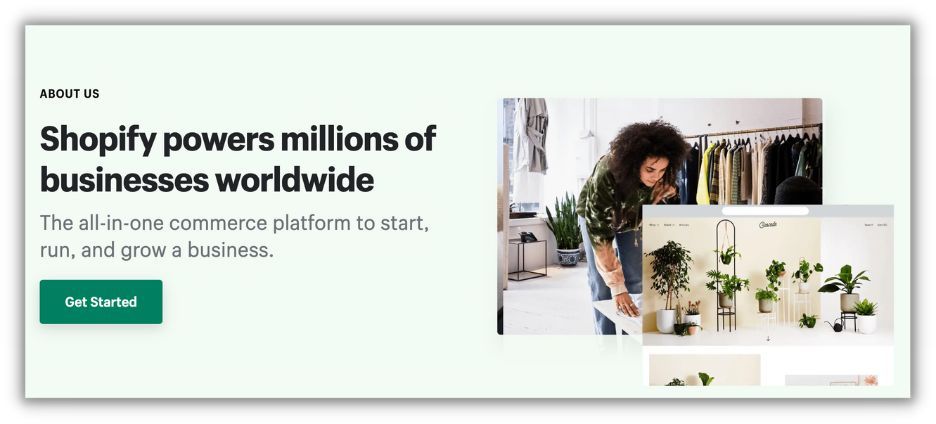
Even though it’s straightforward (and directly builds on its mission statement to “Make commerce better for everyone”), the statement still communicates a big appealing goal. Who hasn’t had a clunky process with commerce, whether it’s a transaction that doesn’t go through or a return process that’s impossible to complete?
That’s why this structure is great for a template: Make [blank] better for [blank], so that [blank].
You can fill in the blanks to use this for your own vision statement—even just to get started.
2. Zoom
Zoom has a strong vision statement: “Communications empowering people to accomplish more.”
The ubiquitous video meeting platform does an excellent job of sharing how its vision fits squarely into its brand identity.
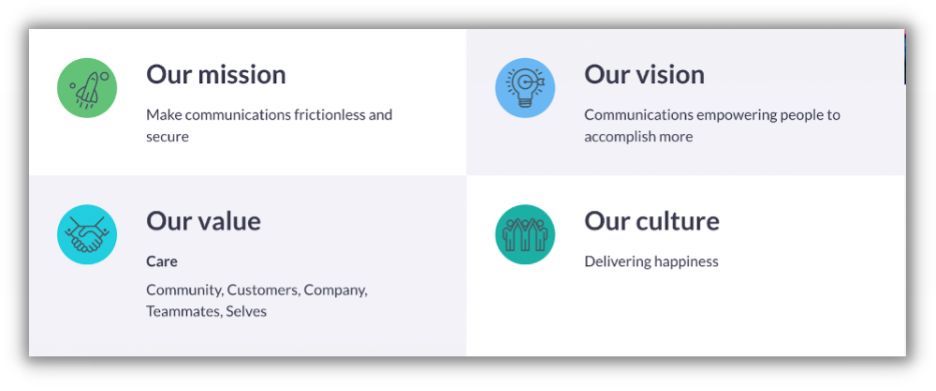
No surprises that a company focused on communication expresses this so effectively.
3. Lego
Lego’s vision statement is simple and joyful: “A global force of learning through play.”

The toy company uses its vision statement to frame its impact reporting. The Lego Foundation is “reaching more children with learning through play,” and the company shares the progress on this goal.
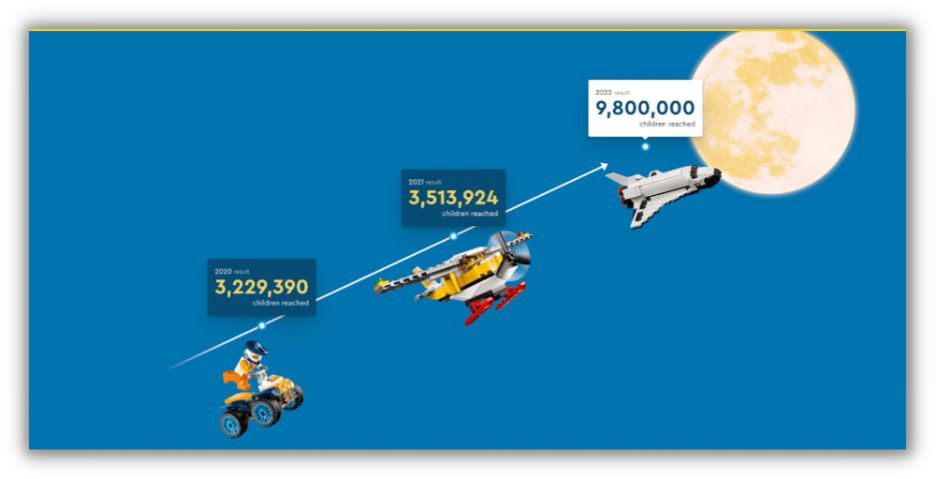
I love how consistent and playful Lego’s branding is, and using the vision statement in action is an extension of this. Plus, it’s good to show that a vision statement isn’t just an aspirational goal—it really is the effect of achieving your mission.
4. Drift
Drift’s vision is clear: “A world where people are free to have a conversation with any business, at any time, on their terms.”
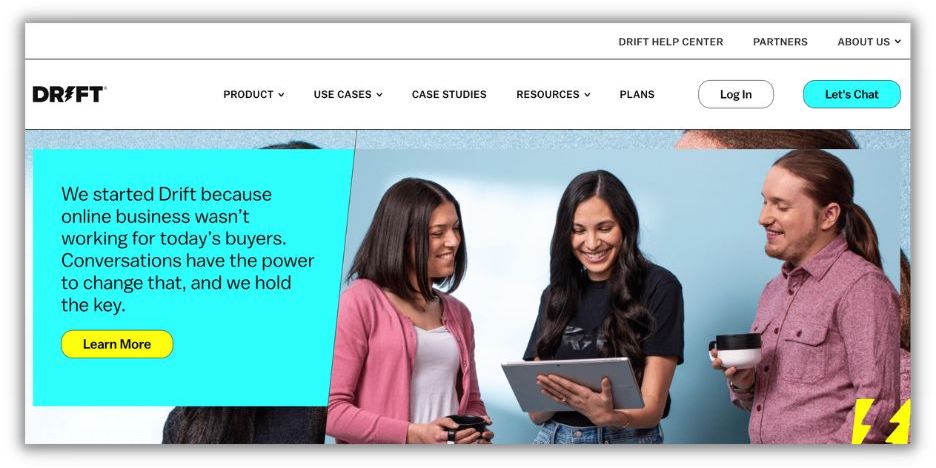
Drift’s chatbots allow businesses to field incoming questions and connect with customers or potential customers at any time. The vision statement shifts the perspective. Instead of focusing on the value to businesses, it highlights the value to all of us as customers. No more waiting to call with questions during business hours again.
5. Labster
Labster is an educational platform for virtual labs and scientific simulations. The company’s vision: “To make science education accessible to any student with an internet connection and a laptop. To help teachers educate and empower the next generation of scientists to change the world.”

This statement appeals to both key user audiences for Labster—students and teachers. Even more, it presents the unlimited potential impact for all of us if we provide future generations with critical science education. Inspiring.
6. Coded Minds
Coded Minds is an edtech startup with a concise but impressive vision statement: “To be the revolutionary platform of choice for educating the next generation of leaders in the 21st century.”
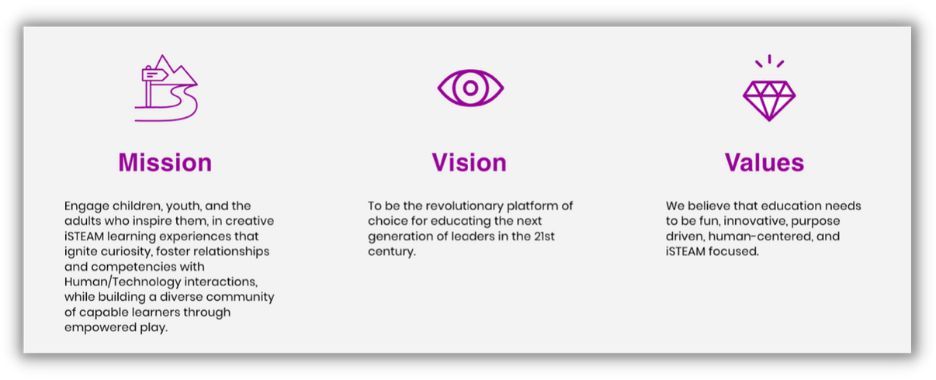
I like this visual because it outlines that company’s long-term goals clearly: The mission is what the company does, the vision is what the company will achieve, and the values speak to why it’s important to achieve it.
This exemplifies the simple significance of the mission, vision, and values exercises.
7. Zendesk
Zendesk’s slogan positions the company as the champion of customer service. Zendesk’s vision is the bigger-picture result of championing customer service for everyone: a global economy powered by lifelong customers.
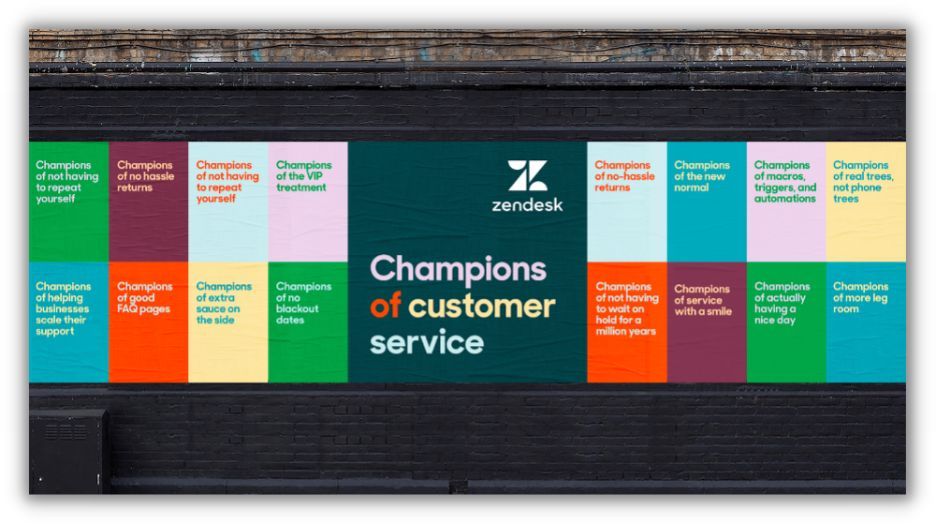
One of Zendesk’s core brand beliefs is that customer service is so important because it impacts all of us. Like Drift, Zendesk is aware that we are all consumers who work with businesses and often need support when we’re doing so. By championing customer service, Zendesk helps businesses help customers—and by ultimately improving consumer experiences, the company is building the economy. The vision is a grand one, but the logic follows nicely.
8. Alltech
Alltech develops agricultural products to help farmers raise livestock and crops to feed the world. The company shares why in its vision statement: “We firmly believe agriculture has the greatest potential to shape the future of our planet.”

This is an inspiring vision that’s particularly motivating for mission-driven employees. It’s a reminder that the day-to-day office and lab work is contributing not only to feeding the world but shaping the future of our planet. That’s a reason to join a company.
9. Nike
Nike’s marketing copy is always crisp and energetic. Their vision statement is no different: “We see a world where everybody is an athlete—united in the joy of movement.”
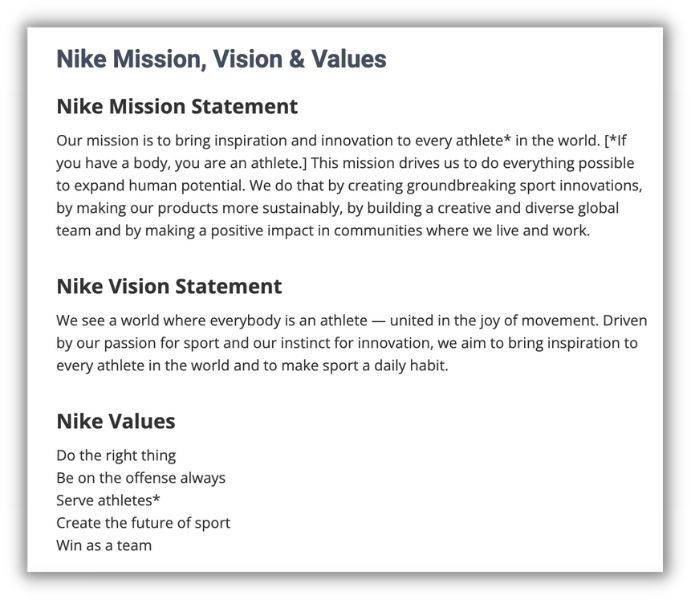
The key idea that everyone is an athlete resonates with the rest of Nike’s branding. The second part of this statement emphasizes the power of claiming and recognizing this shared identity: Unity.
10. Billie
Bille outlines its vision for the company that goes beyond razors and presents a more important purpose: “We want to undo the unfair social pressures women face, starting with double standards around shaving and bodycare, and celebrate the infinite ways women can look, feel, and be in the world.”
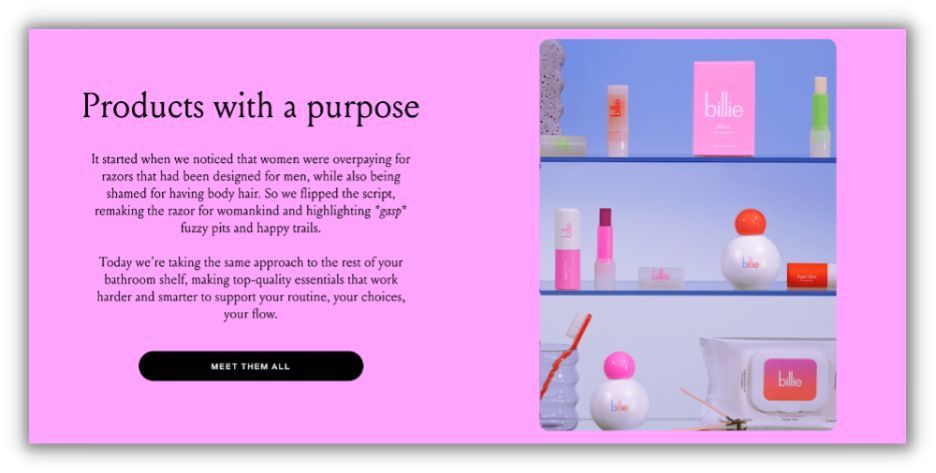
The best part is that this purpose appears throughout the website and product copy, too. The company not only announces its long-term goals, but it references them consistently.
11. Ikea
Ikea might be known for its flat-pack bookshelves and beds, but its vision statement doesn’t mention furniture or furnishings at all: “To create a better everyday life for the many people.”
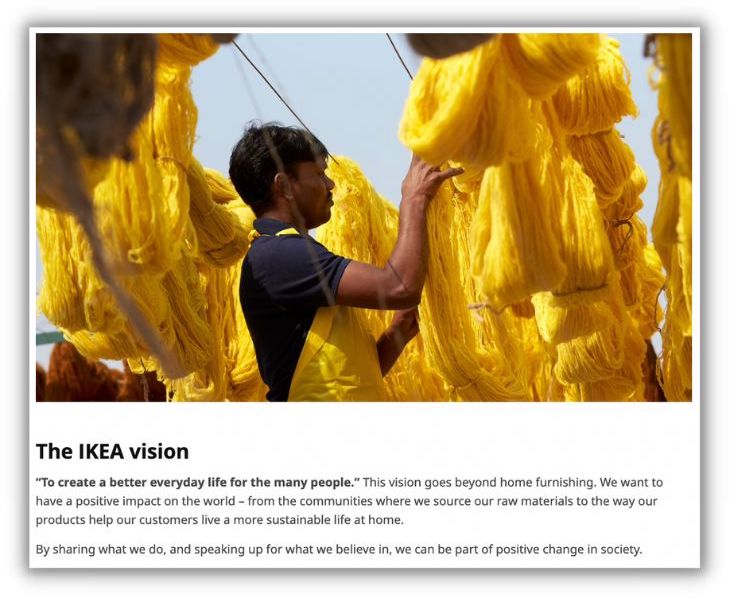
This sounds vague, but really it’s big. Ikea’s vision statement captures the impressive impact that accessible, quality furniture can have on people. It makes life better.
Plus, this leaves the future of the company open to expand beyond furniture—something that would be good to use in your own vision statement, too.
Get started writing the vision statement for your business
You can see from the examples that your vision statement doesn’t need to be complicated or lengthy. Instead, it needs to communicate the long-term purpose of your business and what you’re hoping to achieve. Now, use these examples for inspiration and work through the step-by-step to get started drafting your own vision statement. Good luck!
PPC
10 Most Effective Franchise Marketing Strategies
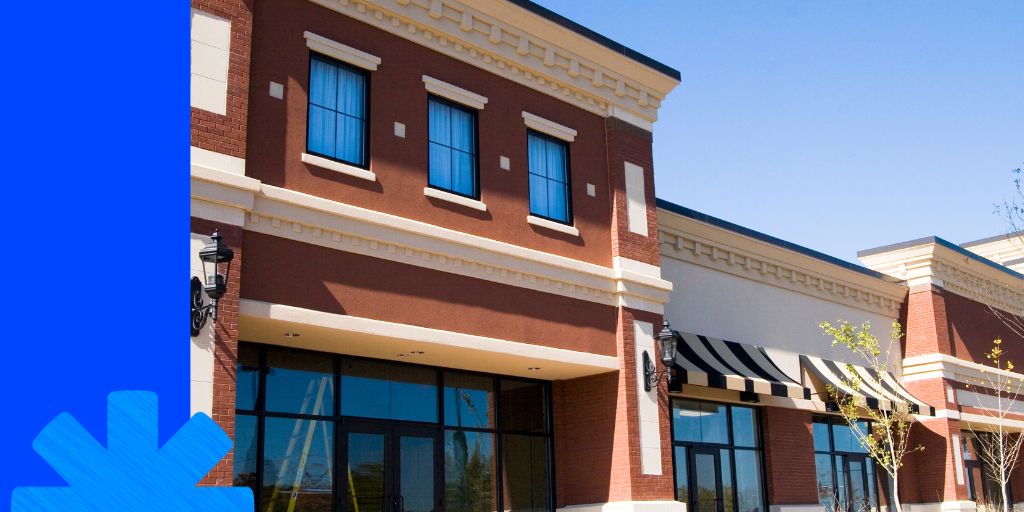
Who doesn’t like a bit of a challenge? While it’s always rewarding to take on new marketing endeavors, certain businesses, like franchises, feel the heat more than others.
Whether you’re a food and beverage franchise, a multi-location dealership, a national real estate group, an enterprise bank, or anything in between, you know that managing marketing efforts across the board can sometimes feel like an uphill battle.
In this guide, we’ll help you address common marketing speedbumps multi-location businesses encounter and share 10 of the most effective franchise marketing strategies.
Contents
What is franchise marketing?
Franchise marketing means promoting your business across all your franchised locations. Essentially, any effort you’re putting into growing your franchise is considered franchise marketing. This can mean marketing efforts at a top branding level all the way down to marketing for specific locations.
Benefits of franchise marketing
Here are a few reasons franchise marketing is so important:
- A new franchise location opens every eight minutes during the course of any given business day. This doesn’t even account for the new businesses opened every day.
- 42% of franchise marketing professionals and multi-location business owners feel traditional marketing channels, like TV placements and PR, are no longer worth the investment.
- 55% of multi-location businesses believe that social media is the leading franchise marketing channel they rely on.
Clearly, there is plenty of competition and opportunity within the franchise and multi-location industries, meaning franchise marketing is crucial to stand out and grow.
However, keeping up with your franchise marketing is easier said than done. Let’s resolve some franchise marketing pain points next.
10 franchise marketing strategies
Managing your franchise marketing can be a juggling act. As the classic saying goes “No pain, no gain!” Let’s dive right into how you can turn 10 major franchise marketing pains into marketing gains:
1. Maintain brand consistency throughout your franchise marketing
It’s no secret that one of the biggest challenges franchise marketers face is location managers or franchisees that go rogue—especially when it comes to branding and brand consistency. But until a teleportation or cloning device gets invented, you’re unfortunately unable to be at all your locations to guide them through their marketing (despite how much you wish you could). This makes maintaining brand consistency across all locations a difficult task.
But brand consistency is extremely important for the success of your franchise marketing. We know that 71% of consumers say they’re more likely to buy a product or service from a brand they recognize. Plus, we can’t forget about the age-old marketing “rule of seven” which states that people need to see information about a business at least seven times before they become a customer.
So brand consistency isn’t just a “nice-to-have” element in your franchise marketing plan, it’s a need-to-have!
How to approach it: The first thing you should do is create a brand style guide. Once you have your style guide in place, you can use it across all locations. If you already have one in place, now is the time to revisit! The more thorough your brand guidelines the better.
Here’s our list of what should go into your brand guidelines:
- Company logo in various sizes and color options (black and white, thumbnail size, banner size etc.)
- Your business’s colors in hex codes
- Your selected fonts in regular, bold, and italics
- Your chosen grammar, mechanics, and style preferences (including punctuation, capitalization, and abbreviation)
- Blog post title preferences
- Image styles and sizes for digital and print materials
- Your business’s boilerplate and mission statement
- Preferred tone and voice
- Social media best practices by platform
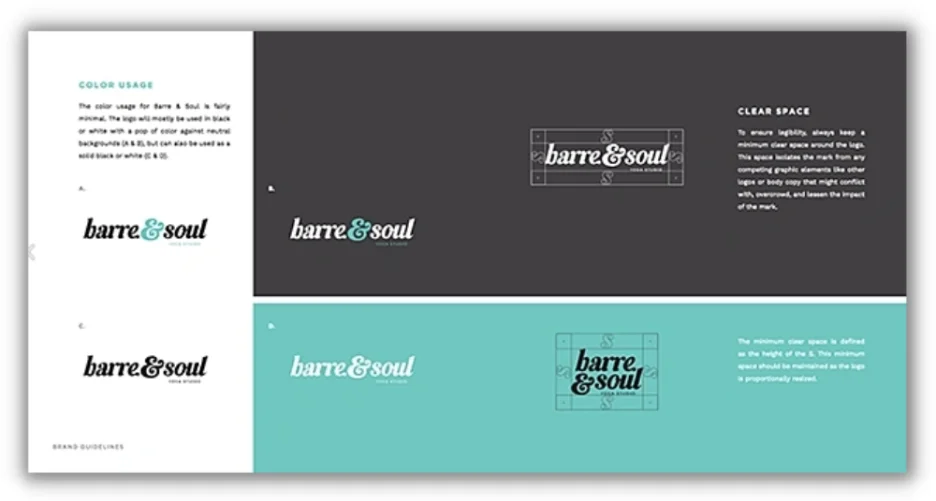
An example of brand guidelines.
Brand guidelines will keep your brand consistent and empower your location owners to create their own marketing collateral while knowing they have a cheat sheet to help them along the way.
📚 Free guide >> 12 Secrets to a Higher Click-Through Rate (& Lower Costs!)
2. Identify your customer base across locations
Let’s face it—your local customers’ interests at your Boston location will be different from those in your Houston location which differs from those in your San Diego location, and so on!
If you generalize your target audience without consideration for how their lifestyles differ by location, not only does that lack of inclusivity limit your reach, but it also gives your customers a less personalized marketing experience.
However, 80% of consumers are more likely to make a purchase when brands offer personalized experiences. So identifying your target audience across locations now to deliver a personalized experience at each location later is a marketing tactic you won’t want to miss out on.
How to approach it: Taking time to identify your target audience across all locations when your plate is already full is easier said than done. A more efficient way to execute this is to look at your target audience from a bird’s eye view and zoom in from there.
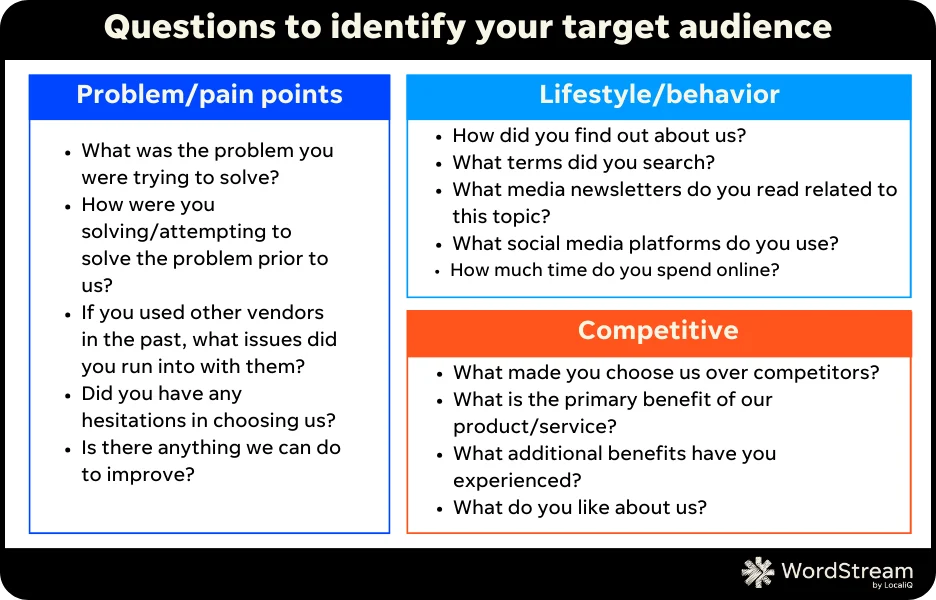

Once you identify what makes up your target audience at a high level you can take it down to the regional level. From there, you can use free online tools like Google Trends to understand the interest of topics by location to see how your messaging may slightly differ between regions.
Another workaround would be to create marketing collateral that’s diverse enough to speak to all customers regardless of lifestyle. A healthy mix of both, however, will give your customers that localized experience while saving you as much time and resources as possible.
3. Know your solution options (+ which ones your brand needs)
There’s an infinite amount of value your franchise has to offer its customers. Add that on top of your many convenient locations, a diverse range of employees, and audience segments, you’ll find it can be challenging to know how to deliver all this information to your potential customers in the best way.
With so many potential marketing channels to choose from, how do you know which strategies will be most effective? And how can you communicate your chosen strategies’ effectiveness to your franchise managers?
How to approach it: We’ve broken down the top marketing channels for franchise businesses into a few core pillars. Introduce your franchisees to the following and encourage them to try it for their own benefit:
Search engine optimization
SEO is at the core of any strong marketing plan for good reason—it’s free! Not only do clicks from organic search results come at no cost to you, but with 90% of consumers searching online before making a purchase digitally or in-store, SEO can help each of your locations grow sales faster.
Search advertising
With search advertising, there are now more options than ever for dynamic location targeting at the ad copy and campaign setting level, so your chances of pulling in a click from a select location’s local customer is nearly guaranteed.
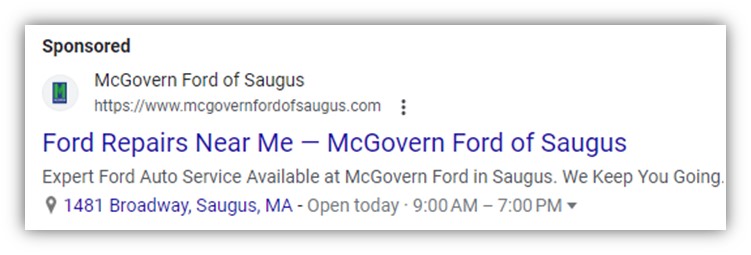

An example of a search ad for a local Ford dealership.
Search advertising ensures you’re showing to potential customers when it matters—as they’re searching on top search engines like Google and Bing. Plus, paid search ads can increase brand awareness by up to 80%. If you have a location that’s struggling to pull in new customers, paid search ads are the best route for making it known to potential customers that you’re in their area with lots to offer.
🛑 Worried you’re wasting spend in Google Ads? Find out with a free, instant audit >> Google Ads Performance Grader
Video/OTT
Video marketing on YouTube or via OTT (over-the-top) streaming allows your franchise or multi-location business to create engaging content for exclusively targeted audiences. Even though you may be juggling various locations and customer bases, you can segment your video marketing in hyper-specific ways to ensure each location gets a piece of the pie.
Plus, video marketing can grow revenue nearly 50% faster and pull in 66% more qualified leads per year than businesses that don’t use video.
Display
Display ads give you a way to target your audience on sites across the web—when they’re not even actively searching for your business. This increases awareness for your brand. If your branch managers notice a dip in sales, display ads could be the solution since consumers who are retargeted via display ads are 70% more likely to convert.
Social
With 3.5 billion active social media users worldwide, it’s no secret that social media marketing is a must if you want to heighten your chances of reaching all the potential customers around each of your locations.
The beauty of social media marketing is that you can get results regardless of whether you decide to go the free or paid route. So if you’re struggling to get all your franchisees on board with one marketing strategy, social media marketing is an accommodating solution with endless options that can fit any locations’ budget (or lack thereof).
Of course, there are additional marketing channels you should consider as part of your strategy. Take a look at all the basics of local marketing to find out what would work for you.
4. Get all locations on board with the right strategy
Speaking of budgets, with multiple franchises, it can be tough to get them on the same page with the marketing spend and strategy that you encourage. Each location has its own needs and budget which you want to accommodate within your recommended marketing plan.
It gets trickier when you want to save yourself time by creating an easily transferrable franchise marketing strategy that can apply store to store but also is flexible enough to not have one set budget applied.
How to approach it: The first thing you’ll want to look at is all the free and low-cost marketing options available. Small businesses have been doing this for years, but for a larger enterprise, this feels counterintuitive. However, the kicker of franchise marketing is it’s the same concept as local marketing—just multiplied.
When you present your location owners with low-cost or free options, they’ll have no reason to not want to implement them. Some examples could be setting them up with a social media account for regular posts or facilitating online workshops to foster their SEO expertise.
With that said, we know that a mix of marketing channels maximizes your chances of results. Ideally, you’ll want your location managers to get on board with allocating some of their revenue toward a marketing budget. The best way to encourage this is to research statistics to display the ROI if they were to go for it and to provide co-op funds from corporate if possible. For example, paid advertising returns $2 for every $1 spent–a 200% ROI.
It’s helpful to keep in mind that marketing budgets don’t have to be huge. It doesn’t always take a lot of money to make a big impact, but a little can go a long way!
5. Evaluate your options for franchise marketing execution
While some franchises are fine with individual locations running their marketing strategies themselves, others opt to streamline marketing from one central team or group for all locations.
Both options present their own sets of challenges. If you’re managing the marketing strategies for all locations, you have a big job—you must not only execute a successful multi-channel marketing strategy that includes optimizing campaigns, writing ad copy, and deploying offers, but you have to do that for different areas and audiences.
If you allow franchisees to run their marketing themselves, you have to worry about brand consistency, optimized spend, and a lack of control around results.
How to approach it: It doesn’t have to feel like a lose-lose situation when you choose which route out of the two you want to take. As mentioned above, both managing marketing for your locations versus letting them manage it comes with pros and cons.
To identify what’s best for your brand, we recommend doing a self-evaluation with the following questions:
- How much extra time do I have to oversee my locations’ marketing strategies?
- How much time do my location owners have to put into marketing?
- Would implementing marketing at the location level require any training?
- What types of marketing channels do I need to have running at each franchise location? Can each location handle those themselves?
- Has my company struggled with brand consistency in the past?
- How would I measure the success if I ran the marketing for all franchise locations? How would those locations measure and report on their own success?
- How frequently would I expect to change up the marketing strategy?
- Is it easy for me to consistently communicate with all of my locations?
Depending on your answers, you’ll end up leaning towards one over the other. However, if you’re still unsure then that’s totally fine! Another option would be to involve a marketing partner to help oversee your franchise marketing strategies along with you. That way you won’t have all the locations’ marketing on your shoulders, and you can leverage a resource that has every marketing tool needed at its fingertips.
Whatever you decide, finding the right tool to track your marketing across locations and channels will be crucial for measuring success. (We’ll talk more about this in a minute!)
6. Create a strong local SEO strategy
You need to focus on SEO that is both national and local. National often comes naturally to many franchise businesses at this point, but without a strong local SEO approach, you won’t be able to show up for searches when and where it counts.
How to approach it: The easiest way to complement your national SEO with a local SEO strategy is to include keywords related to your locations within your content—this can be easily done through location pages on your website. The next quick fix for multi-location SEO is to invest in listings management so local listings are accurate for each location to help drive leads. It may seem minor, but 64% of consumers have used Google Business Profiles to find contact details for a local business.
Additionally, try to position your brand as a partner to each of your locations by creating local-friendly blog content. Brainstorm a blog topic that’s specific to each one of your locations, and you’ll save time on your editorial calendar planning while also staying consistent with local content!
You can also quickly research other local businesses to link to for resources within your content to build trust with your local audiences. That said, maintain a friendly presence in your local communities by encouraging location managers to participate in local events to trigger brand awareness for searches later.
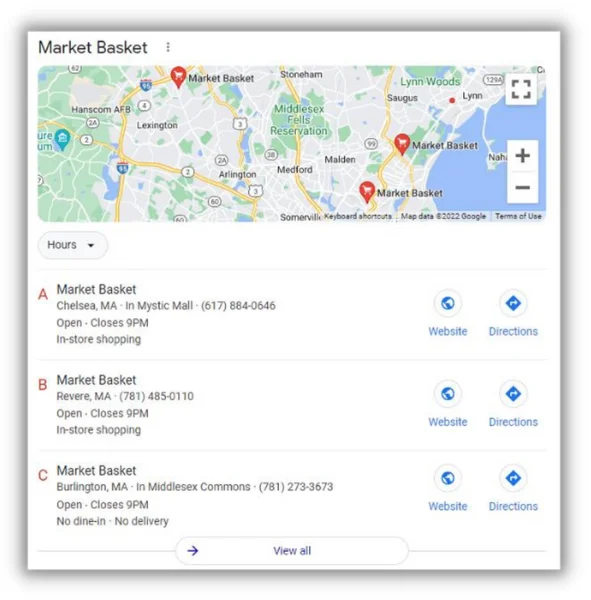

This multi-location business has Google Business Profile listings for each store location to fit local SEO needs.
🔎 Need help finding the right keywords for your local SEO strategy? Try our Free Keyword Tool!
7. Be sure to stand out from the competition (including your own franchisees!)
Franchises have a unique competitor set in that while you compete with other local businesses and large brands, you might also compete with your own locations. For example, you might have two locations down the block from each other that own two completely different territories but could be competing for the same customers. One major hurdle every franchise must jump over is how to run marketing at each location without stepping on one another’s toes—all while stepping on the competition’s toes!
How to approach it: We can’t stress enough how important geo-targeting is to your multi-location or franchise marketing. Geo-targeting is a way to ensure that one location’s marketing collateral doesn’t slip onto the screens of consumers in another location’s territory. When you run ad campaigns with geotargeting you’re maximizing the overall growth of your business by handing out a fair, even slice of the cake (or in this case, audience) to each store.
As for standing out from the competition, geotargeting can also help here if you want to identify and target their locations too. Otherwise, bidding on competitors’ branded keywords will help to ensure your brand shows when folks are looking for your competition. That way you can sweep the competition’s customers away and bring them to your locations.
8. Solidify reporting for all locations, solutions, AND channels
Let’s get this straight: your business has multiple locations, offering multiple products or services, overseen by multiple managers, marketing to multiple different audiences, through multiple different channels. What a handful!
You don’t have time to loop in hundreds of data points into one performance tracking sheet. You need some way to ensure that all your franchise marketing efforts maintain a growth track with proven KPIs.
How to approach it: For this instance, technology is your new best friend! Take advantage of digital tools that aggregate reporting across platforms, locations, and more to report on what matters. A few things you should ask yourself while scouting a reporting solution include:
- Do you want your location managers to have access?
- What performance metrics matter most to your multi-location business?
- What does a positive performance look like for you at the national level? At the local level?
- What channels need to be tracked? How will they be tracked consistently across locations?
- What timeframes will you be looking to run reports on?
- What types of downloadable or shareable files, if any, will you want for your reports?
9. Educate your franchisees on franchise marketing
You and your franchisees are busy running a national brand at the local level—you all don’t have time for in-person pieces of training on all your marketing technology and best practices! Never mind the fact that gathering the resources to help location owners understand your brand’s marketing plan is a feat in and of itself.
How to approach it: Have fun with it and get creative with your training! You can hold training online after hours to make it easy for all your branch managers to attend.
Another way to make marketing education more accessible across locations is to create various training materials. For example, you can shoot or share quick “how-to” YouTube videos for visual learners. For busy location owners short on time, you can write and email training articles that they can read in bits throughout the day.
The more training material, the better. If your schedule is so jam-packed you can’t even begin to think about running training or creating training materials, leveraging a marketing partner to facilitate training for you is another great option.
10. Communicate with your marketing partners
You may have one agency helping with social that has a totally different approach than your in-house team managing paid search. Or each location might be working with their own team or consultant. How do you keep multiple teams and marketing partners aligned?
How to approach it: If you’re struggling to keep track of all your marketing solutions, then it may be worth it to find a marketing partner that can bundle all your needs into one. When you leverage a marketing partner that can house all your channels and reports under one roof it’s easier to maintain consistency and performance tracking.
In the meantime, though, communication is key! Be sure to hold regular meetings with your in-house team, your location managers, and your agencies to maintain consistent cohesion across channels.
This is also another opportunity to distribute your style guide to all marketing partners so that there’s no confusion across agencies, marketing associates, or consultants on what your brand’s voice is.
Solve these franchise marketing puzzles today to decode a brighter tomorrow
If there’s one thing we can take away from all 10 of these franchise marketing tips is that the more you can plan ahead and communicate with your locations, the easier your job will be later. Plus, no matter your goals, channels, or audiences, there’s a solution out there that can work for your franchise.
With a bit of creativity and finesse, you can make your franchise marketing strategy do the heavy lifting for you. Putting in the time to square away your challenges now is worth the time it will save you later.
To recap, here are the top franchise marketing tips we talked about:
- Prioritize brand consistency throughout your franchise marketing
- Get to know your customers across locations
- Consider all your franchise marketing channel options
- Get all your locations on board with your overall franchise marketing strategy
- Evaluate your options for franchise marketing execution
- Ensure your local and national SEO strategies align
- Try to stand out from your franchise marketing competition
- Be sure to have clear reporting in place
- Train your locations on your franchise marketing efforts
- Consistently communicate with your marketing partners
PPC
Biggest Trends, Challenges, & Strategies for Success

Pay per click (PPC) advertising is a big deal in digital marketing, especially in the retail world. As 2024 heats up, we’re not just talking about simple ad placements and bids; it’s all about smart technology, understanding your customers, and getting creative with your strategies.
Whether you’re a pro in digital marketing or just starting to explore ecommerce ads, keeping up with PPC trends is crucial. This guide is here to help you out.
Contents
Biggest trends in PPC for retail
Let’s dive into the PPC scene for retail in 2024. Things are getting exciting with Google’s ad platform evolving rapidly, especially with its use of AI and machine learning.
Increased use of AI and machine learning
Often, we talk about AI as if it’s one big thing, but it’s more nuanced. AI is the broader concept of machines being able to carry out tasks in a way that we’d consider “smart.” Within this, machine learning is a specific subset of AI that trains a machine how to learn. In the PPC world, this distinction is key.
This year, AI will be transitioning away from merely a novelty. It is becoming smarter, a trend we can refer to as Smart AI. This new phase of AI is more targeted and informed, indicating a significant evolution in how AI systems are developed and applied.
🤖 Want to use AI the right way? Free download >> Emergency Guide to AI in Marketing
AI in ad targeting
AI’s role in PPC is about understanding and predicting. It sifts through tons of data to figure out what consumers are looking for, then predicts their buying patterns. This means your retail PPC ads are more likely to show up for people who are genuinely interested in what you’re selling.
Machine learning in real-time optimization
Machine learning steps in to continuously improve how your retail ads perform. It adjusts bids, manages budgets, and identifies trends that you might not notice. It’s like having an assistant who’s always optimizing your campaigns, ensuring they reach the right audience effectively.
Mastering these technologies is crucial for digital marketers in retail. It’s not just about using these tools; it’s about understanding them deeply and leveraging their strengths to boost your PPC campaigns.
Top PPC strategies for retail in 2024
Here are four essential PPC strategies for retail digital marketers:
1. Try Demand Gen campaigns
Recently, Discovery Ads campaigns were automatically upgraded to the Demand Gen campaign type in Google Ads.
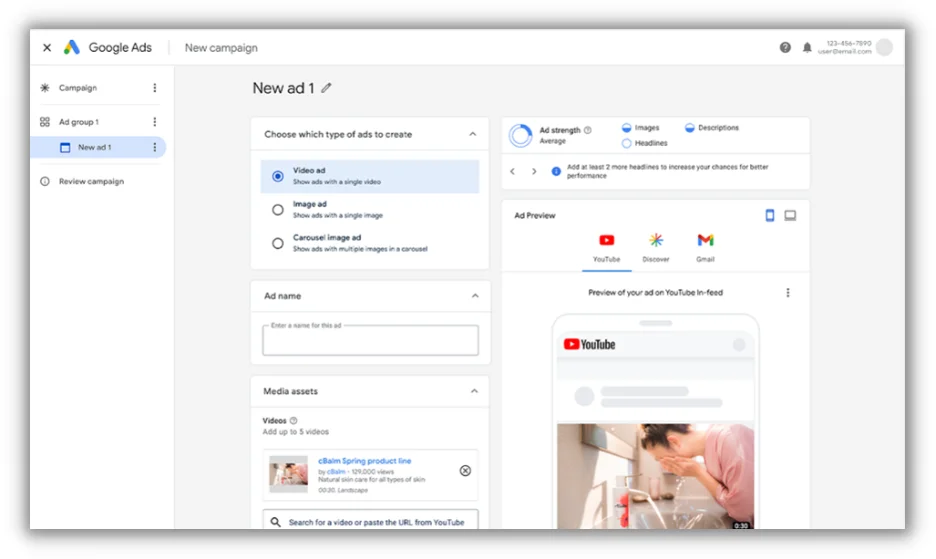
Demand Gen is more than just an upgrade–it’s a game-changer in winning social budgets for Google. Early testers have shown that Demand Gen campaigns deliver better performance when compared to Discovery Ads. That means more qualified traffic, more conversions, and more growth for your business or clients.
2. Embrace automation and smart bidding with Performance Max
In the realm of PPC, automation is crucial. Performance Max, a feature of Google’s automated bidding system, helps optimize ad placements across various channels. At the same time, new Demand Gen formats on Google platforms are changing the game. By using these engaging and visually appealing ads, you can attract potential customers right at the onset of their search journey.
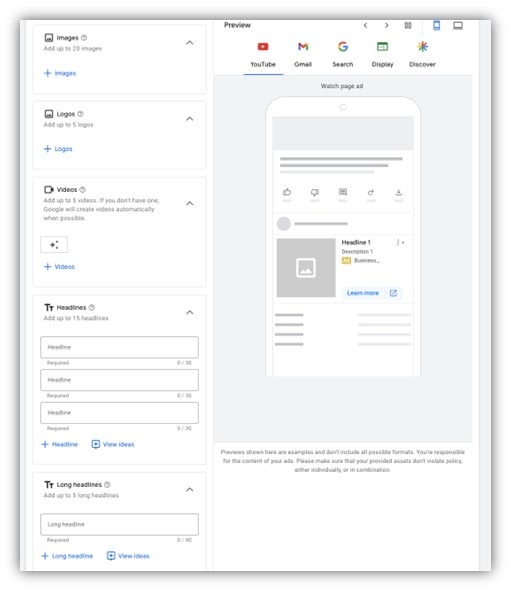

Combining Performance Max with innovative ad formats ensures your ads are not only seen but also resonate with your target audience.
3. Experiment with AI
AI, specifically through tools like FeedGen, is revolutionizing how product feeds are optimized. By employing Google Cloud’s Large Language Models, like Bard, FeedGen enhances product titles, descriptions, and attributes, offering a unique way to experiment with AI in your marketing strategy. For integration instructions, visit here.
4. Explore ecommerce on diverse platforms with cross-channel and omnichannel strategies
Expand your PPC horizons beyond Google Shopping. Embrace the dynamic advertising opportunities on platforms like TikTok, Facebook, and Instagram. Each of these platforms caters to different audience segments and offers unique ways to engage with potential customers.
Integrating these platforms into your advertising mix, alongside traditional channels, creates a holistic and impactful PPC strategy for retail that aligns with the multifaceted nature of today’s consumer behavior.
Implementing these strategies in your PPC campaigns can lead to more effective and engaging marketing efforts, keeping you ahead in the competitive retail sector of 2024.
🛑 Worried you’re wasting spend in Google Ads? Find out with a free, instant audit >> Google Ads Performance Grader
Common challenges and solutions in PPC for retail
Let’s take a look at the common PPC challenges (and the solutions to these challenges) that retail advertisers run into.
Challenge 1: Ad saturation and viewer fatigue
The digital world is awash with ads, making it a challenge for retailers to stand out and capture attention, often leading to viewer fatigue.
Solutions
- Create unique, engaging content: Develop content that answers potential customer queries, positioning your brand as a solution at the top of the funnel. Focus on being helpful and informative.
- Try dynamic ad formats and personalization: Use diverse ad formats and tailor your messaging to connect more effectively with your audience. Personalization can help break through the clutter.
- Experiment and test: Try different creative approaches to discover what resonates best with your audience. Keep your content fresh and engaging.
- Apply the 80/20 rule: Dedicate most of your content to educate and engage (80%) rather than direct selling (20%). This approach can build trust and provide value to your audience.
- Be consistent with content creation: Regular updates and new content can keep your audience engaged and interested.
- Monitor and adapt based on metrics: Regularly check your campaign metrics to understand what’s working. Analyze data like click-through rates, conversion rates, and engagement levels. Double down on strategies and content types that show success. Being data-driven in your approach allows you to refine your tactics continuously and do more of what works best.
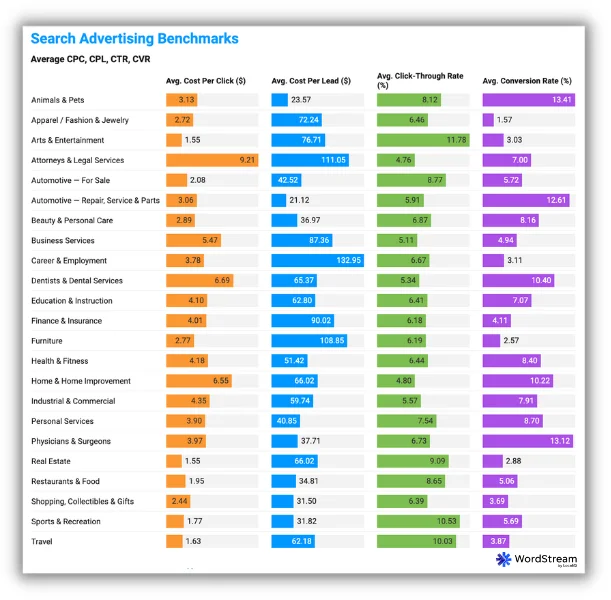

Take a look at our search advertising benchmarks to see how your metrics compare.
By combining these strategies, retailers can better navigate the challenges of ad saturation and viewer fatigue, making their PPC campaigns more effective, engaging, and relevant to their target audience.
Challenge 2: Balancing automation and human insight
While automation in PPC is powerful, an over-reliance on it, such as solely depending on Google Ads’ auto-apply settings, can lead to missed opportunities for optimization. Automation can sometimes miss the subtleties that a professional digital marketer can catch.
Solutions
- Think of AI and automation as assistants, not replacements. As a professional digital marketer, your experience and insights are invaluable. Use automation tools for efficiency but maintain control and oversight for strategic decisions.
- Regularly review the performance of your campaigns with a critical eye. Remember, the auto-apply settings in Google Ads might not always align with your unique goals.
Your role is to guide these tools, making manual adjustments and infusing your campaigns with the strategic depth that only human experience can provide.
Challenge 3: Measuring and attributing ROI accurately
Accurately tracking the return on investment (ROI) from PPC campaigns can be complex, especially when dealing with multiple channels and customer touchpoints.
Solution
Invest in advanced analytics tools like Google Analytics 4 (GA4), which is designed with privacy in mind. GA4 offers features such as default IP anonymization, region-specific controls for features like Google Signals, and the ability to mark events as non-personalized ads. Additionally, you can set shorter data retention periods and have more accurate data deletion options, including deleting data for individual users upon request.
These features not only enhance privacy compliance but also provide a clearer understanding of attribution models. This approach allows for more effective tracking of the customer journey and helps in attributing conversions accurately to the right campaigns, all while maintaining user privacy.
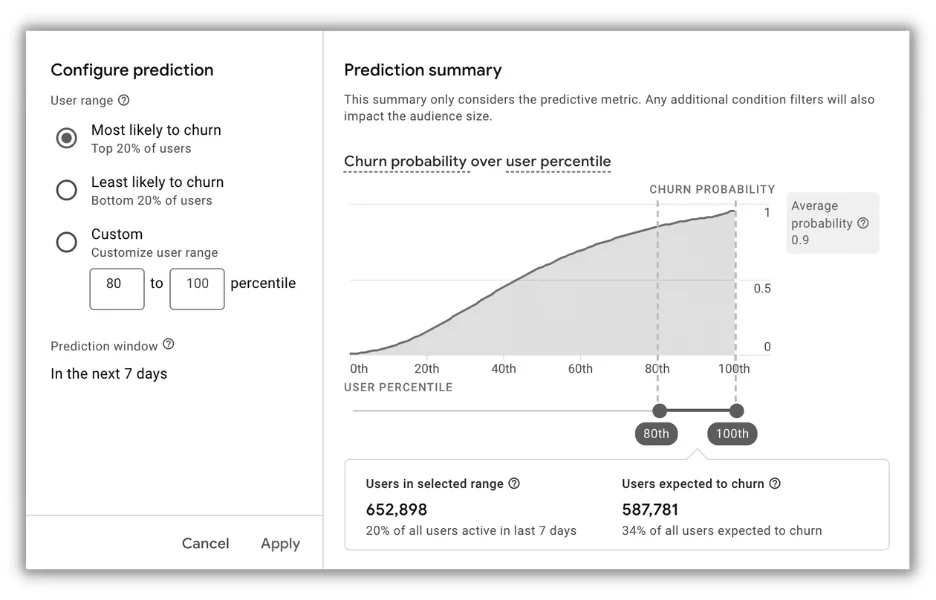

Challenge 4: Keeping up with rapid technological changes
The pace of change in PPC tools and algorithms can be overwhelming, especially for smaller retailers with limited resources.
Solution
Stay informed about industry trends and updates. Consider joining online communities, attending webinars, or collaborating with digital marketing experts to keep your strategies current.
Challenge 5: Navigating privacy regulations and data restrictions
Retailers are increasingly challenged by the need to balance effective ad targeting with strict privacy regulations like GDPR and CCPA.
Solution
Emphasize transparency and user consent in your advertising strategies. Utilize Google’s Consent Mode and adopt a consent management platform to ensure compliance with privacy laws.
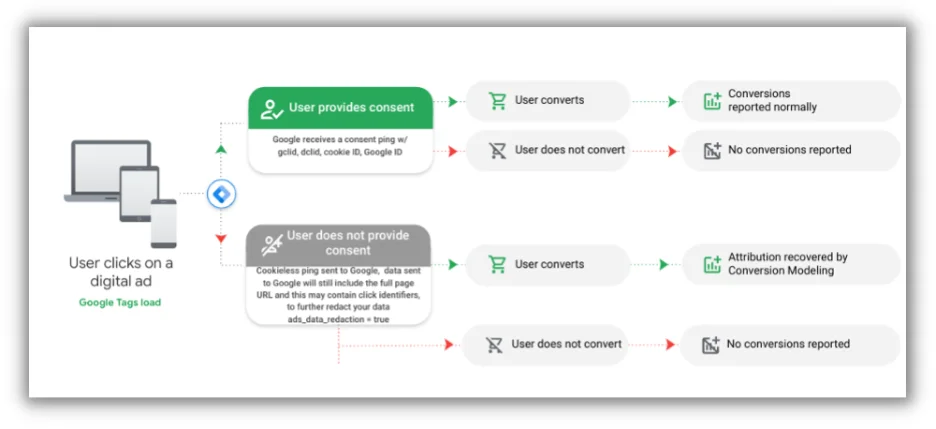

By leveraging contextual targeting and first-party data, you can still deliver personalized experiences while respecting user privacy. Investing in privacy-compliant tools and practices not only builds trust with your audience but also ensures the sustainability of your ad campaigns in a privacy-focused world.
Make the most of your PPC for retail campaigns
Navigating the PPC landscape in 2024, especially in the retail sector, is both challenging and exciting. The key to success lies in striking the right balance between leveraging advanced technology and maintaining the human touch that defines your brand. By focusing on creating unique, engaging content that educates and resonates with your audience, personalizing your messaging, and using dynamic ad formats, you can stand out in a crowded digital space. Remember, it’s not just about catching the eye but also about building lasting relationships with your customers.
Embrace tools like Google’s Performance Max and AI-enhanced solutions like FeedGen for efficiency and effectiveness, but don’t forget the value of your professional insight and experience. Always be ready to adapt, innovate, and refine your strategies based on real data and customer feedback.
In the fast-changing digital marketing world, thriving retailers recognize the need to adapt, embrace new tech, and stay true to customer values.
Here’s to making your PPC retail campaigns impactful, not just successful!
PPC
19 Best SEO Tools in 2024 (For Every Use Case)

Whether you’re a local mom-and-pop shop or a multinational enterprise, SEO is still the best play for long-term traffic growth and lead generation. A single optimized blog post, web page, or video can attract thousands of qualified visitors for years—and you don’t have to spend a dime to promote it.
That said, SEO isn’t easy. Every marketer knows how valuable the top of a Google results page is, and it keeps getting harder to own that real estate.
That’s why we’ve trialed, tested, and categorized the best SEO tools available in 2024. Whether you’re publishing your first blog post or optimizing a 5,000-page website, there are SEO tools here to help.
Contents
What are SEO tools?
In broad terms, SEO tools are software that helps you automate, streamline, or support your SEO strategy.
More specifically, SEO tools can help with:
SEO tools come in a few varieties. Some are feature-rich, comprehensive software with several tools to tackle many SEO tasks. Ahrefs is a good example of a comprehensive SEO tool since it helps with on-page SEO, off-page SEO, site audits, and more. Our Keyword Tool is a point-solution since it has one function—to help you find the best SEO keywords to target.
What is the most effective tool for SEO?
That’s like asking, “What’s the best vehicle?” Do you want to haul a lot of people, a lot of stuff, or do you just want to go fast?
Like car shopping, picking your SEO tool starts with understanding your needs. Here are some questions to consider:
- Are you new to SEO or a power user of SEO tools?
- What’s your budget?
- Do you have specific jobs to do, like auditing a blog with 5,000 posts or doing initial keyword research?
- How big is the team that’ll use the SEO tool?
- What type of organization is it (a marketing agency, affiliate marketing group, ecommerce shop, SaaS company, etc.)?
While each use case has its own set of needs, there are a few foundational characteristics we used to compile our best SEO tools list, including:
- User experience: Is the interface and workflow intuitive? Does the design help new users find what they need quickly?
- Value: Does the cost justify the software’s capability? Is it competitively priced versus similar tools?
- Feature/use-case fit: Does the tool have everything you’ll need to complete the task it’s built for?
- User feedback: Positive reviews and high ratings on sites like G2 and Capterra.
Best free SEO tools
These SEO tools are either completely free or have a robust free tier with plenty of functionality.
1. Exploding Topics for SEO keyword trends
Exploding Topics is a neat little tool that helps you get in early on soon-to-be popular topics. The tool constantly scans the web, looking for increasing patterns of searches and mentions for any specific term.
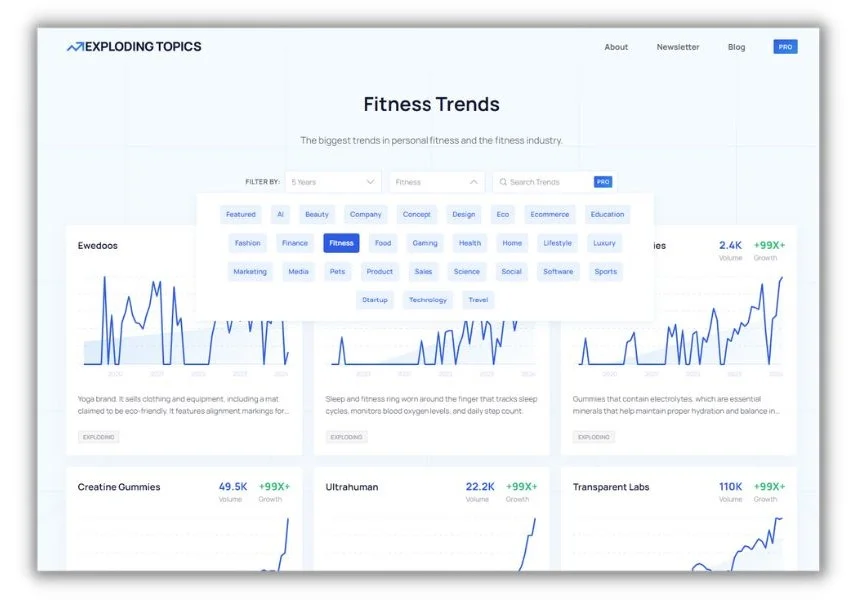
Note that you can’t enter any old search term to see what’s trending. But you can choose from a bunch of topics that may be important to your brand.
The data doesn’t just come from search engines (although the software does “listen” to millions of searches). When you see a trending topic, it’s because it’s also been mentioned, commented on, and discussed all over the internet. That’s why this tool is good at exposing not just what people search for but also what they’ll likely search for in the near future.
There’s no cost to pop in anytime and see what’s trending for each category. The paid plans start at $39 and give you tracking, alerts, and detailed reports (like tracking specific product categories).
2. WordStream’s Free Keyword Tool for unlimited keyword research
One of the hardest parts of SEO is finding keywords with the right balance of search volume and low difficulty. Our Free Keyword Tool helps you overcome that hurdle by quickly surfacing a list of relevant keywords and the data you need to pick the best options.
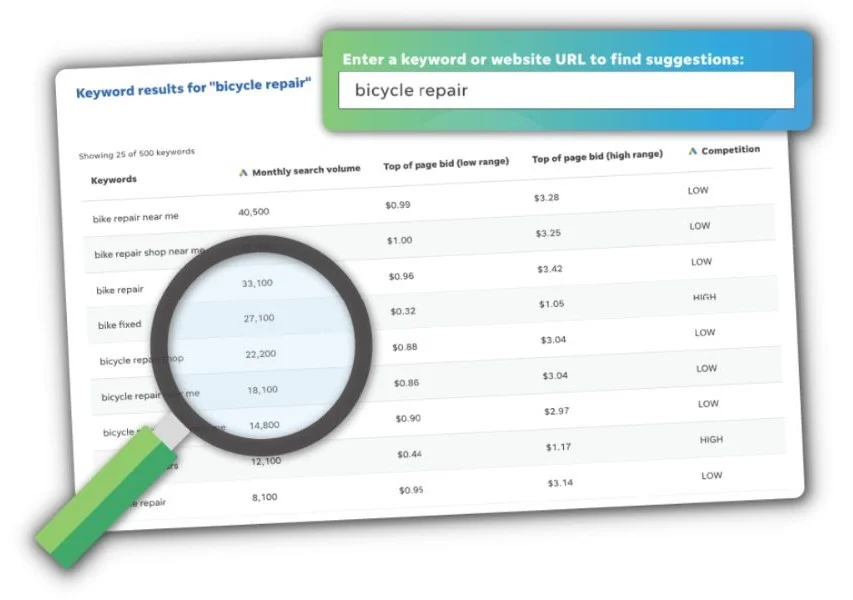
I like to use it once I’ve brainstormed a list of seed keywords (terms I think people might search for). Just drop the word or phrase in the search bar, and you will get a list of related terms, plus their monthly search volumes and competition levels. It’s pretty easy to spot those high-volume, low-competition keyword unicorns.
The price of the tool is in the name. It’s always free for an unlimited number of searches.
3. Animalz Revive for refreshing SEO content
Over time, SEO blog posts often lose their ranking to new content. Revive, from the content marketing agency Animalz, locates these decaying assets on your blog.
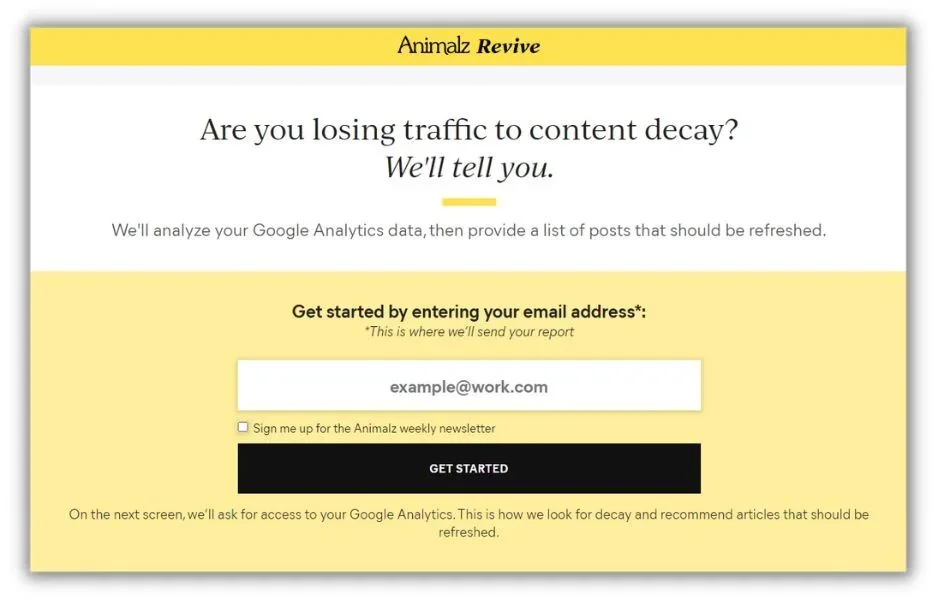
The tool works by reviewing your Google Analytics (you have to give it access) to spot blog posts with a downward traffic trend. Once it’s finished, you’ll get an emailed report with a list of content that could rank and get more traffic once it’s refreshed.
The tool is free, but you do have to give up your email address to access it.
4. Similarweb for competitive SEO analysis
Similarweb gives you a sneak peek at the performance and ranking of any public website on the internet. Its free version is surprisingly comprehensive.
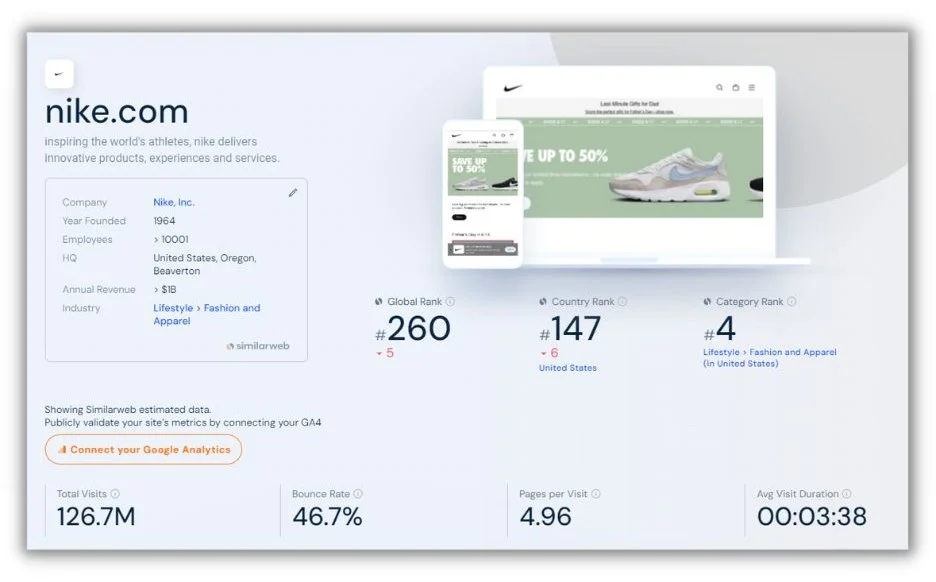
Enter a URL and scroll to see estimated traffic and engagement stats, site traffic demographics, traffic sources, and more. You can even compare two websites side-by-side.
I wouldn’t take Similarweb data as gospel. It pulls “digital signals” from millions of locations across the internet and creates statistically significant estimates. It’s excellent for directional insights, though. If five of my competitors show a lower bounce rate than the pages I’m working on, it’s a signal that I need to make some user experience improvements.
Basic website analysis is free on Similarweb. There are several data points, like top outgoing links and referral traffic sources, you’ll have to pay for.
5. LocaliQ’s Website Grader for free SEO audits
If you need a quick, easy-to-understand website audit, LocaliQ’s Free Website Grader will do the trick.
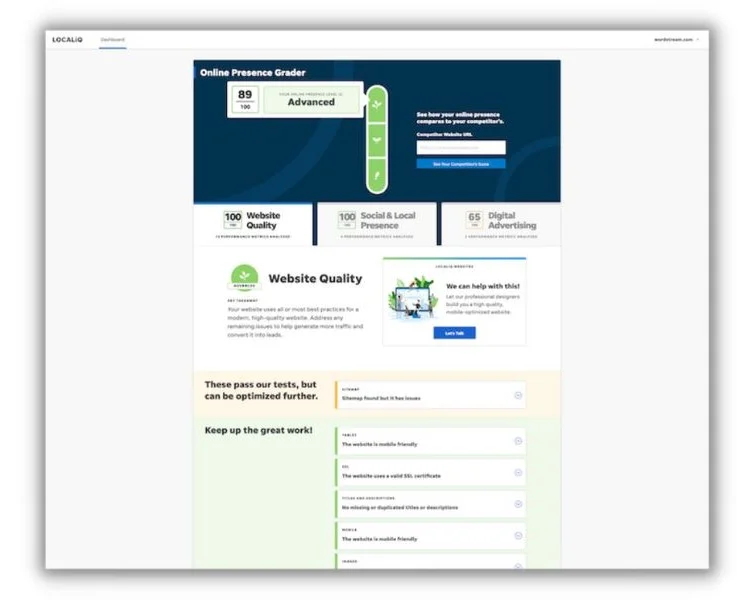
Even though it’s a free tool, you get a lot of information. For example, in your report you’ll see:
- Technical SEO: Site security, site speed, mobile optimization
- On-page SEO: Metadata, word count, alt text
- Off-page SEO: Links from other sources
It’s plenty enough to create a good checklist of SEO improvements.
Free reports are delivered by email, and you can run them as often as you like.
Best AI-powered SEO tools
Many of the tools in this guide have some type of built-in AI functionality for SEO. But we found a few that stand out for their use of AI’s ability to process huge amounts of data and generate SEO insights.
6. Outranking for SEO outlines
There are loads of generative AI content tools out there now. What sets Outranking apart is that it’s focused on helping you create content that’ll rank well on search engines.
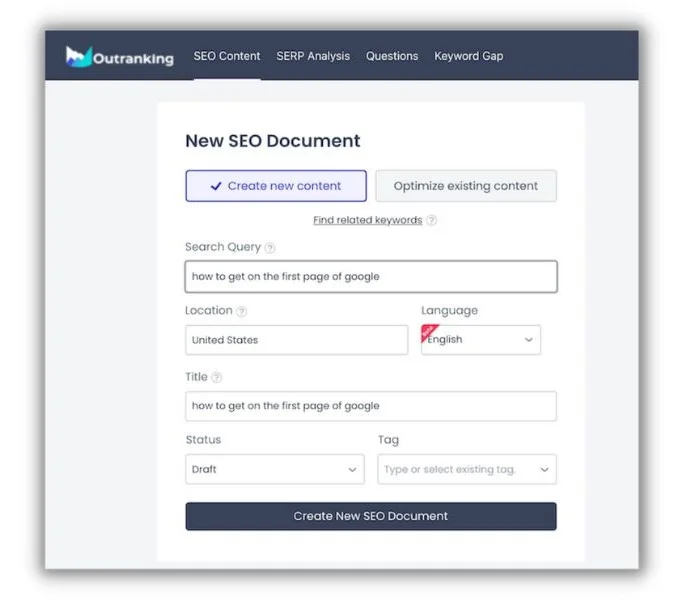
With a free account, you can input a search query, location, language, and title, and it will generate an SEO outline that you can customize. It’s really helpful if you regularly write content briefs for others to complete. Like any generative AI content tool, double-check the output and add your own voice.
Outranking pricing tiers start at $29 monthly for five new SEO documents and AI-assisted SEO optimization for existing content.
7. CanIRank for keyword competition
CanIRank is a personalized keyword difficulty tracker on steroids. It reviews your website’s existing SEO clout and then tells you if you can rank for specific keywords.
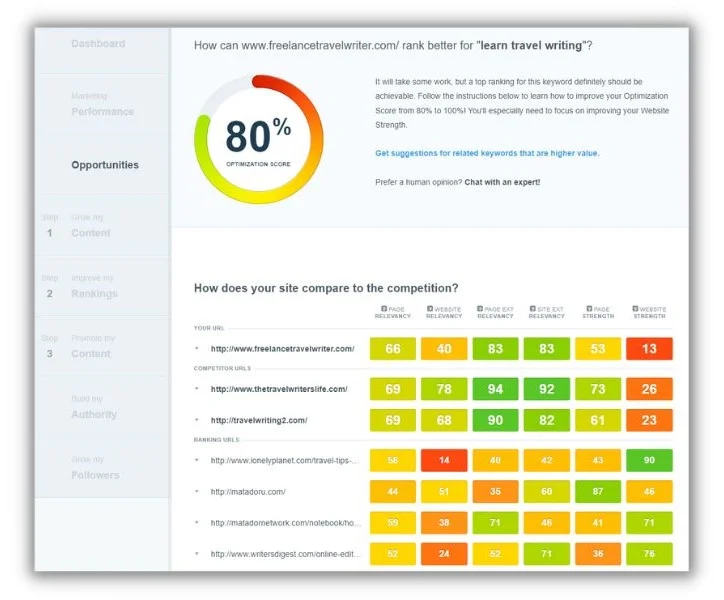
Here’s the real magic of CanIRank. It doesn’t just tell you which keywords to target; it leverages AI to give you specific steps to help your content rank higher.
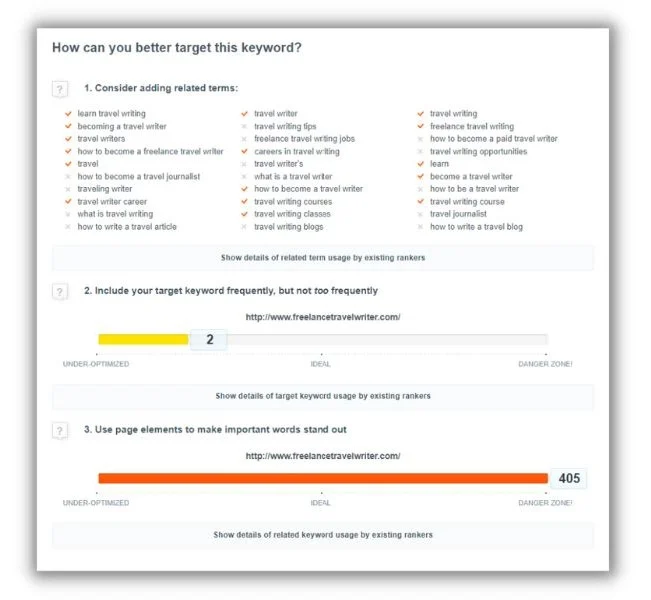
CanIRank lets you review one website for free (plus get five keywords and SEO reports daily without paying). The paid plans for more websites and keyword reports start at $49/month.
8. Keyword Insights for keyword clustering
Keyword Insights is a paid keyword research tool that uses AI in two interesting ways. First, it uses algorithms and machine learning to locate clusters of topics from a single keyword.
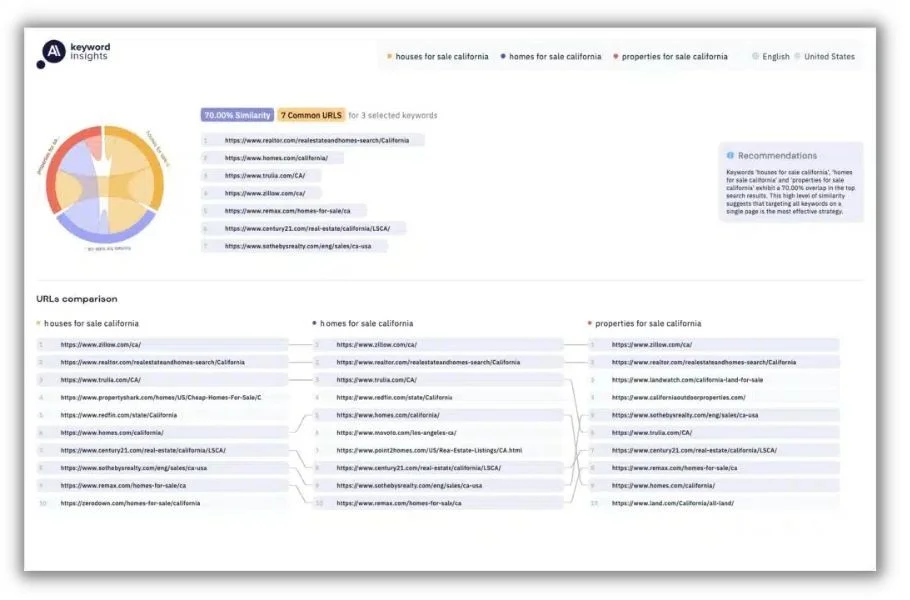
Keyword clusters help you target multiple longtail keywords in a single post or a linked group of posts. Google sees your exhaustive coverage as topical authority on the subject and bumps you to the top of the SERPs for those related keywords.
Then, once you have a keyword cluster defined, Keyword Insights uses AI to generate a brief or outline based on the existing posts in the SERP plus data from Reddit, Quora, and People Also Ask boxes.
A note of warning here. Generative outline creators like Keyword Insights are a great way to create a base outline quickly. But to earn your spot on the SERPs, make sure you add something extra like personal experience, expert quotes, or another facet of the topic other SERP leaders don’t have.
Keyword Insights offers a four-day trial for $1. Monthly paid plans start at $58.
9. Diib for keyword and rank monitoring
Google SERPs are in constant flux. You can gain or lose page-one ranking for any given keyword in a day. Diib uses predictive AI to monitor all sorts of SEO vitals for your website, but the keyword tracking will keep you abreast of turbulent search pages.
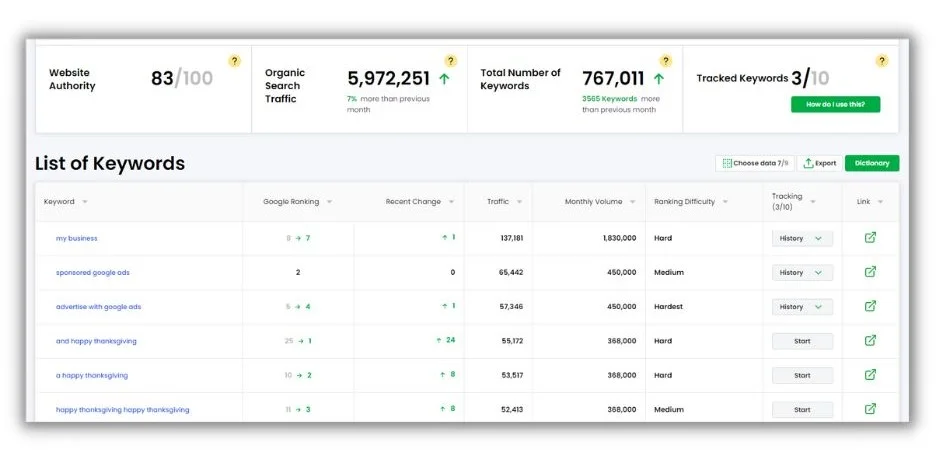
With Diib, you can add high-priority keywords to a monitoring list. It’ll show you those at the top of your keyword reports and let you see their history of performance on the SERP. But the best part is that the tool will also notify you when your rankings change for those keywords. The heads-up lets you take action, like updating the page’s UX or adding new information.
The pricing provided to us was an initial $99 startup fee and $14.99 for each subsequent month.
🛑 Get the free Guide to AI in Marketing and learn the most effective ways to use AI (and the ways you shouldn’t be).
Best local SEO tools
It’s cliche but true: Local SEO is critical for location-based businesses. 77% of people say they’ve used Google to find businesses like a coffee shop, dentist, or HVAC tech nearby. These tools are designed to ensure that you show up on SERPs when those people need you.
10. GeoRanker for location-specific SEO tracking
If your customers come from a specific geography, you need to know if your website ranks for relevant keywords in that location. GeoRanker has a feature that lets you track that.
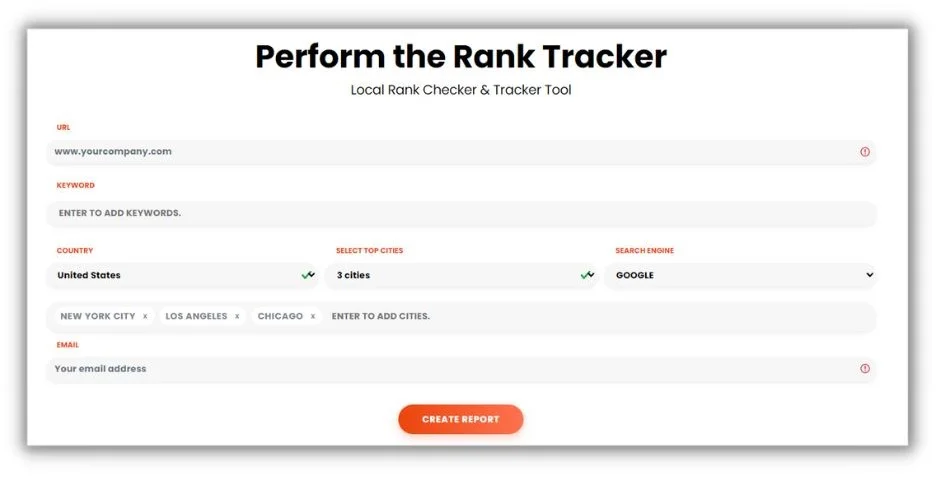
Once you fill out the form, GeoRanker returns a report showing the position—in real-time—your website holds for your target keywords in the cities or countries you’ve picked. You can also see how your rankings have changed and learn where your competitors land on those SERPs.
The tool would be really handy for multi-location businesses, as it allows you to get data for each city you have a presence in.
GeoRanker also has a location-dependent SERP checker that shows the top 100 results for a keyword in different cities. For example, “coffee shop” will have different results in Chicago vs. Phoenix.
GeoRanker gives you limited access to its tools for free, with a monthly subscription plan starting at $99.
11. LocaliQ’s Free Business Listings Grader for directory audits
Online business directories like Yelp and Google Business Profiles are like the digital age’s answer to the Yellow Pages. If you want your local business found online, you need updated, correct information on your listings in those directories. LocaliQ’s Free Business Listings Grader lets you instantly verify your business listing on 20+ online directories.
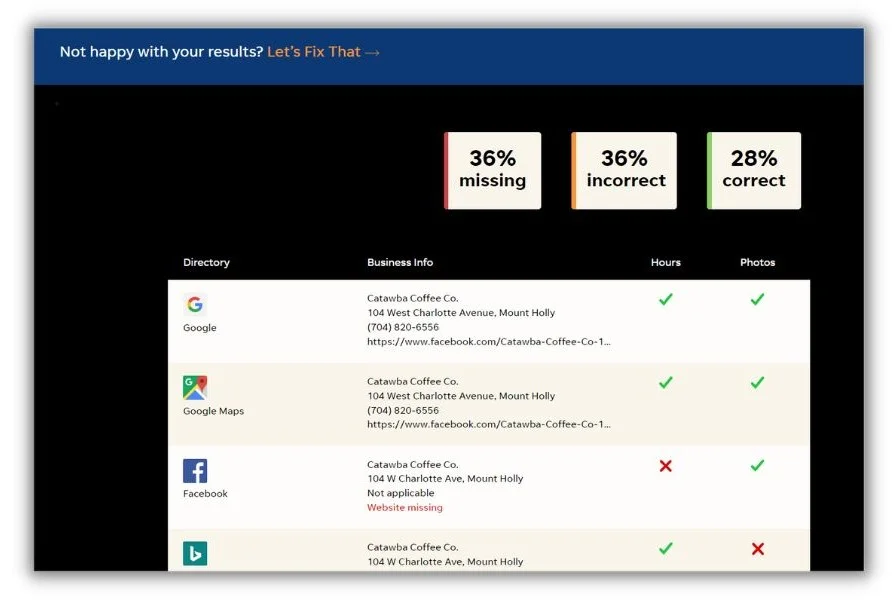
The Listing Grader is very easy to use. Just enter your company’s name, street address, and postal code, and then the Grader will check it against what’s currently shown on apps like Waze, eLocal, and dozens of other locations. It’s a great way to check many business listings at once.
LocaliQ’s Listings Grader is free for an unlimited number of reports.
12. Yext for review monitoring
Reviews can directly affect how your business appears in local searches. Yext has several features to help you manage your online presence and reputation, but I really like its review management functionality for local SEO.
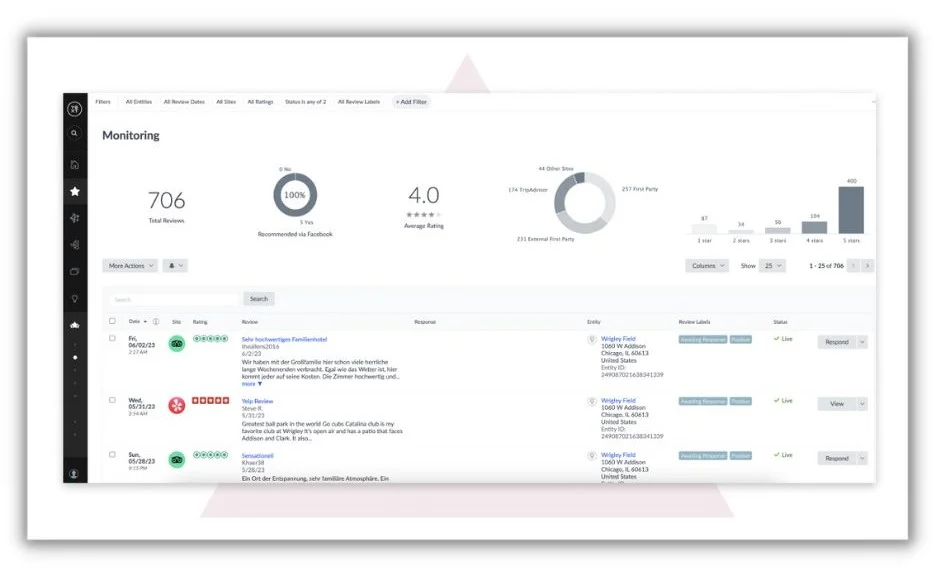
Using API integrations, Yext pulls reviews from all over the web and places them on your dashboard. From there, you can see how people rate your business and what they’ve written. You can also set up notifications so you always know when a new review comes in.
Besides monitoring reviews, Yext lets you respond to (via auto-responder or manually), request, and analyze reviews for their sentiment.
Yext pricing is on request.
Best Google SEO tools
If you succeed in SEO, then Google succeeds. So it’s created an impressive list of tools to help you research, optimize, and analyze all aspects of your website’s ability to rank. These three tools are free, so I’ve not included pricing information individually.
13. Search Console for technical SEO
Technical SEO sounds daunting (and it can be). But Google Search Console helps you track and visualize several aspects of your technical SEO, making it easier to understand and improve.
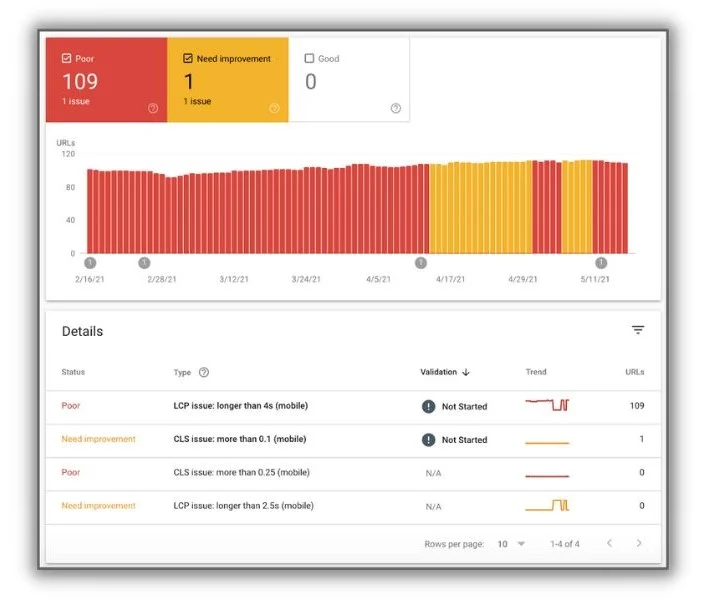
Here are a few ways you can use GSC to see which technical aspects of your website are hurting or helping your SEO:
- Confirm that Google’s crawlers are properly indexing your web pages
- Monitor and troubleshoot your Web Core Vitals or mobile usability issues
- Submit sitemaps
- See security issues
We wrote a guide explaining how to use Google Search Console for technical SEO.
14. Google Trends for timely keyword planning
Google Trends tells you how often a word or phrase is entered into Google relative to the total volume of searches over a set time. Essentially, it’s a real-time keyword popularity report.
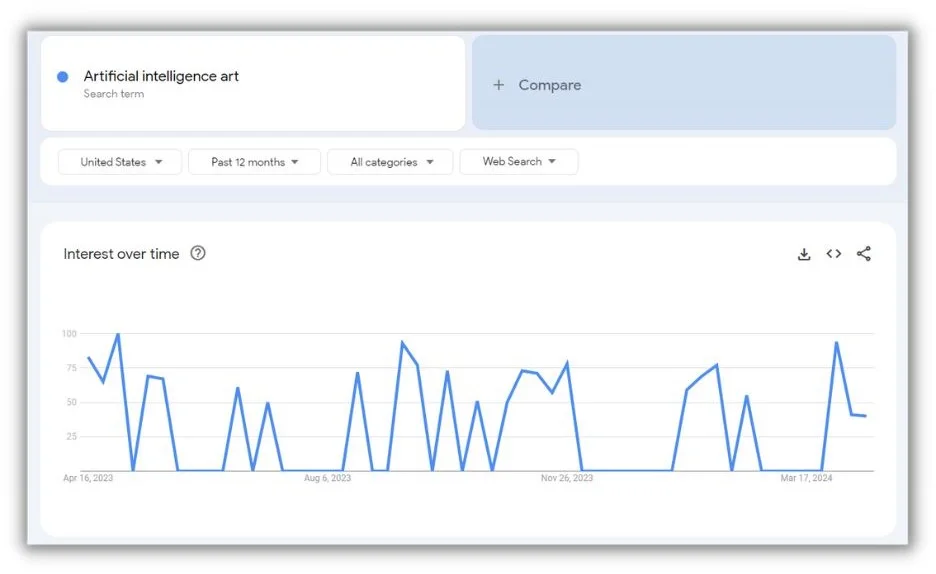
On Search Trends, you won’t see the total number of searches for a keyword. Instead, you’ll see how the search volume changes over time, using the highest and lowest search volumes for context.
You can change the time period, region, and type of search (image, news, Google Shopping, etc.) to see how they affect the trend. You’ll also get a graphical representation of the region you’ve chosen (U.S., worldwide, etc.) that shows the relative searches in each subregion. You even get related terms to inform your keyword strategy.
This guide will help you use Google Trends to its fullest.
15. Google Analytics 4 for SEO performance tracking
Google Analytics 4 (GA4) is a platform that tracks how people arrive at and interact with pages on your website.
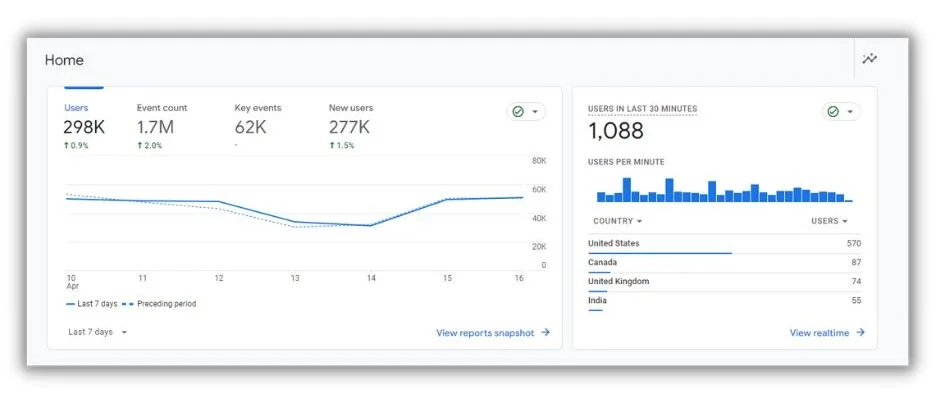
There’s an incredible amount of data that can be parsed in hundreds of ways on GA4. A few of the most valuable insights for SEO are:
- How much of the traffic to your site and individual pages comes from organic search
- Which blog posts and pages get the most traffic
- Which pages are losing traffic from search engines
GA4 is the latest iteration of Google’s analytics platform. Here are a few ways GA4 differs from Universal Analytics, its most recent predecessor.
Best paid SEO tools
If you have the budget, these SEO tools combine rich functionality with excellent user experience. While they all charge a fee, we’ve chosen those that provide the best bang for your buck.
16. Ahrefs for best overall functionality for the money
I’ve used Ahrefs for years for keyword research, rank tracking, competitor analysis, and several other essential SEO tasks. Ahrefs edges out its competition based on the value of what you get, especially for light to moderate SEO users.
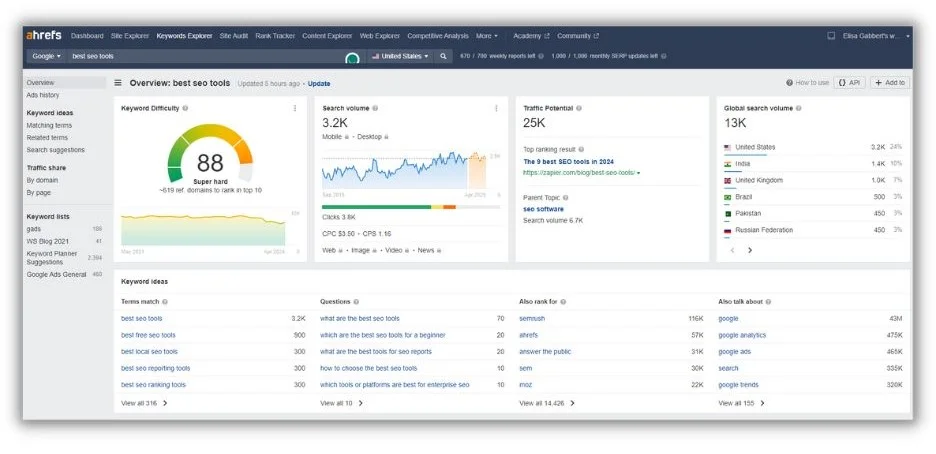
I could write a few thousand words trying to cover all the tricks and tools embedded in Ahrefs’ platform. But for now, here are a few of the functions I use most often to give you a feel for what it can do for you:
- Site Explorer: Enter any website or webpage URL, and Ahrefs will tell you its ranking for specific keywords, how many backlinks it has, where they’re from, estimated traffic, and much more.
- Keywords Explorer: See search volume, difficulty, and which pages rank for any keyword.
- Competitive analysis: Get a list of keywords your website doesn’t rank for, but your competitors do.
Ahrefs pricing starts at $99 per month, with the $199-per-month Standard Plan being what most average users will likely need.
17. Semrush for hardcore SEOs
While Ahrefs is a good value for many SEOs, Semrush delivers more detailed and in-depth data in several areas, making it a better fit for highly technical users.
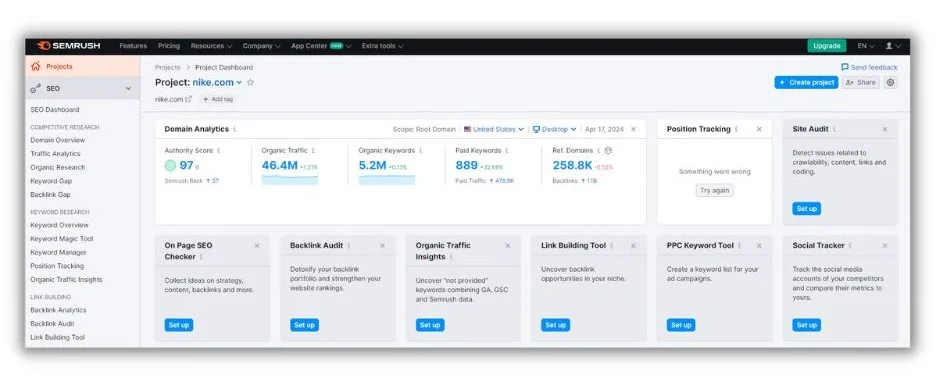
Take keyword research, for example. Semrush gives you search volume trends, Google PPC keyword data, keyword intent, and search volume and difficulty.
Ahrefs also shines in its technical SEO audit reporting and has a few more rank-tracking features.
Semrush pricing starts at $129.95 (just make it $130!) per month, and its mid-priced plan is $249.95 monthly.
18. Screaming Frog for finding common SEO issues
Screaming Frog works like Google Search Console in that it crawls (hops?) through your website, looking for things that might hurt its performance. The difference is in the issues Screaming Frog looks for and the insights it offers to fix them.
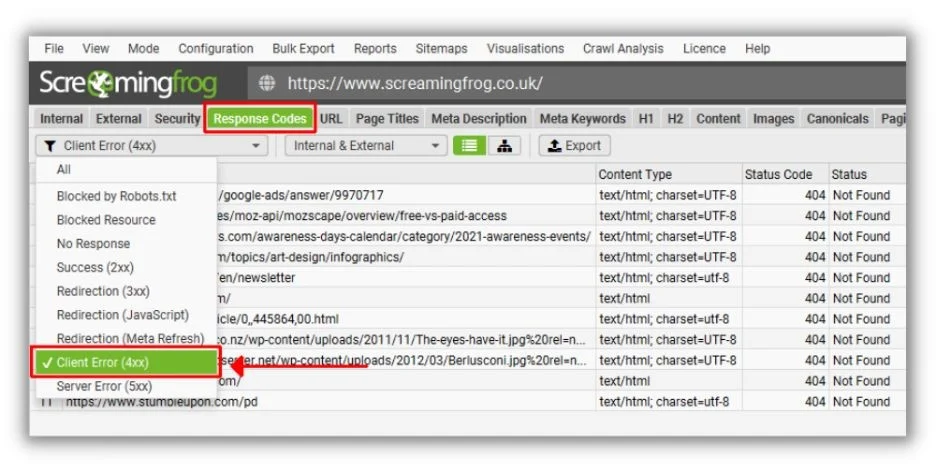
The learning curve for Screaming Frog is a little steep for non-technical SEOs. But if you’ve ever been involved in an SEO audit, it won’t take long to catch on. Once you do, you’ll quickly find things like broken links, problematic titles and meta tags, and incorrect redirects. You can also generate XML sitemaps and site visualizations.
A free version of Screaming Frog lets you crawl up to 500 URLs. The paid plan costs $249 per year and adds functionality like audit scheduling and a near-duplicate content checker. It also allows for unlimited URL crawls.
19. AnswerThePublic for topic ideation
AnswerThePublic is a content topic idea generator. It’s different from keyword research tools because it pulls ideas directly from Google’s drop-down, autocomplete queries (like when you enter “back pain” and Google suggests “…relief” and “…causes”). Then, it presents those keyword variations visually.
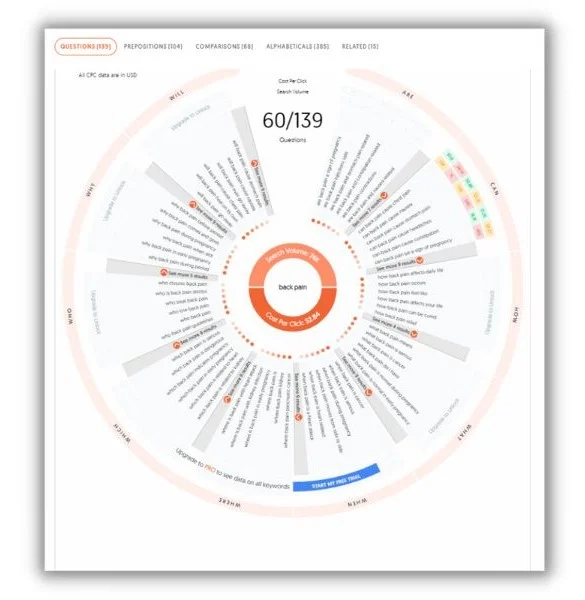
Once you’ve entered a root keyword, AnswerThePublic will tell you all the standard information about it, such as volume and the cost per click for search ads. Scroll through the report, and you’ll see a preposition report (keyword variations using “is,” “to,” “with,” and so on). Keep scrolling, and there’s a report that compares the cost-per-click and search volume for several related keywords.
AnswerThePublic has added Bing, TikTok, Amazon, and YouTube to the sites you can target for keyword research.
Once you register, you’ll get three keyword reports per day for free, although some of the data is withheld. Monthly paid plans start at $9, and a lifetime plan starts at $99.
The best SEO tools in 2024
Despite some rumors to the contrary, SEO remains one of the most valuable long-term marketing strategies for driving traffic and generating leads for your business.
But it continues to get more competitive. Manual keyword guessing and piecemeal SEO audits won’t put you in a great position to rank on SERPs. With the right SEO tools in your kit, you’ll punch way above your weight against much larger websites.
Here’s a recap of the best SEO tools available by use case:
- Exploding Topics for SEO keyword trends
- WordStream’s Free Keyword Tool for unlimited keyword research
- Animalz Revive for refreshing SEO content
- Similarweb for competitive SEO analysis
- LocaliQ’s Website Grader for free SEO audits
- Outranking for SEO outlines
- CanIRank for keyword competition
- Keyword insights for keyword clustering
- Diib for keyword and rank monitoring
- GeoRanker for location-specific SEO tracking
- LocaliQ’s Free Business Listings Grader for directory audits
- Yext for review monitoring
- Search Console for technical SEO
- Google Trends for timely keyword planning
- Google Analytics 4 for SEO performance tracking
- Ahrefs for best overall functionality for the money
- Semrush for hardcore SEOs
- Screaming Frog for finding common SEO issues
- AnswerThePublic for topic ideation
-

 PPC4 days ago
PPC4 days ago19 Best SEO Tools in 2024 (For Every Use Case)
-
SEARCHENGINES7 days ago
Daily Search Forum Recap: April 16, 2024
-

 SEO7 days ago
SEO7 days agoGoogle Clarifies Vacation Rental Structured Data
-

 MARKETING6 days ago
MARKETING6 days agoStreamlining Processes for Increased Efficiency and Results
-
SEARCHENGINES6 days ago
Daily Search Forum Recap: April 17, 2024
-

 SEO6 days ago
SEO6 days agoAn In-Depth Guide And Best Practices For Mobile SEO
-

 PPC6 days ago
PPC6 days ago97 Marvelous May Content Ideas for Blog Posts, Videos, & More
-
SEARCHENGINES5 days ago
Daily Search Forum Recap: April 18, 2024














